

Rewards Case Study: Starbucks Rewards
Starbucks is a staple coffee brand with more than 32,000 locations in over 80 countries around the world. It’s safe to say Starbucks has an abundance of loyal customers. The iconic brand has revolutionized the coffee industry and changed the way everyone consumes coffee. Starbucks took something that had been done the same way for decades and turned it upside down with effective partnerships, beautiful branding, and a variety of types of coffee drinks. They have been doing things differently ever since, including customer loyalty.
Starbucks Rewards is often regarded as one of the best retail loyalty programs in existence and one of the most engaged among its members. According to a CNN report, by October 2022, there were 28.7 million active Starbucks reward members. Giving Starbucks a 16% year-over-year growth in its loyalty program.
They have created a loyal following of customers both with their customer experience and revolutionary rewards program. But recent changes to its loyalty program have its members criticizing the new changes. It’s now going to cost more to earn that free drink and menu item, meaning customers will have to work harder to earn those stars.
Let’s dive into what makes Starbucks Rewards unique and what we can learn from its recent changes in loyalty.
Changes no one asked for
Starbucks Rewards has over 28.7 million active reward members and with new changes to its rewards program that went into effect last month in February, customers were not happy. Starbucks increased the amount of “stars” (loyalty points) customers will need to redeem items.
Here is the breakdown of what changed:
- What costs 50 stars increased to 100 stars.
- What costs 150 stars increased to 200 stars.
- What costs 200 stars increased to 300 stars.
- Hot coffee or tea, baked goods, and packaged snacks will be 100 stars, up from 50.
- Lattes, frappuccinos, parfaits, and hot breakfast items will be 200 stars, up from 150.
- Sandwiches, salads, and protein boxes are 300 stars, up from 200.
Currently, Starbucks reward members can earn 1 star per every dollar spent if members just pay with a credit, debit card, or cash in-store or pay in-app. Members can earn 2 stars per dollar if they preload money into their rewards account or register a gift card to pay with.
Idk if anybody told y’all BUT @Starbucks made their rewards about 50 stars more to redeem. It sucks a lot. What used to be 50 stars is now 100. Lol now I don’t even want to use them. 🥹 — AshCash ✌🏾 (@TechBaeAsh) February 16, 2023
With the recent changes, that free iced coffee or chocolate croissant will cost a bit more, $100 to be exact if you’re paying with cash or a debit card or $50 if you preload money in your account. To earn that free cold brew or a breakfast sandwich, you will have to spend $200 if you’re paying in cash or $100 if you preload your account.
The reason for the change is unclear if it's because of inflation or the rising cost of products everywhere. According to an Axios report, Starbucks said it was due to the changing needs of customers. “We occasionally need to make changes to ensure the long-term sustainability of the Starbucks Rewards program and to meet the changing needs of our members.” Members will disagree.
Starbucks really moved the reward levels back……..in this economy — Jobe Bean Bryant (@jeauxdeci) February 27, 2023
How Starbucks Rewards misses the mark
Starbucks Rewards is one of the best examples of customer loyalty and how to build a brand community. Based on its recent changes and the reactions from customers, there are a few ways Starbucks Rewards misses the mark.
1. Changes no one wanted
Why change something when it’s not broken? Starbucks customers have tweeted, commented, and made dozens of TikTok videos on the unwanted changes Starbucks made to its reward program.
Customers were given a few weeks' notice of these changes, which left many to have to use all of their points before changes went into effect. Starbucks really missed the mark here because so many customers voiced their dissatisfaction with the recent changes and Starbucks did not relent and went ahead with their changes.
@maddykim16 #greenscreen starbucks is a scam!! #starbucks #stars ♬ original sound - Maddy Kim
2. Current tiers don't create exclusivity
Tiered programs are an amazing way to encourage customers to spend more and engage more. Tiers challenge customers to reach the next level while also introducing an element of gamification that customers love. Tiers are also effective when the highest tier is reserved for only the most loyal and profitable customer.
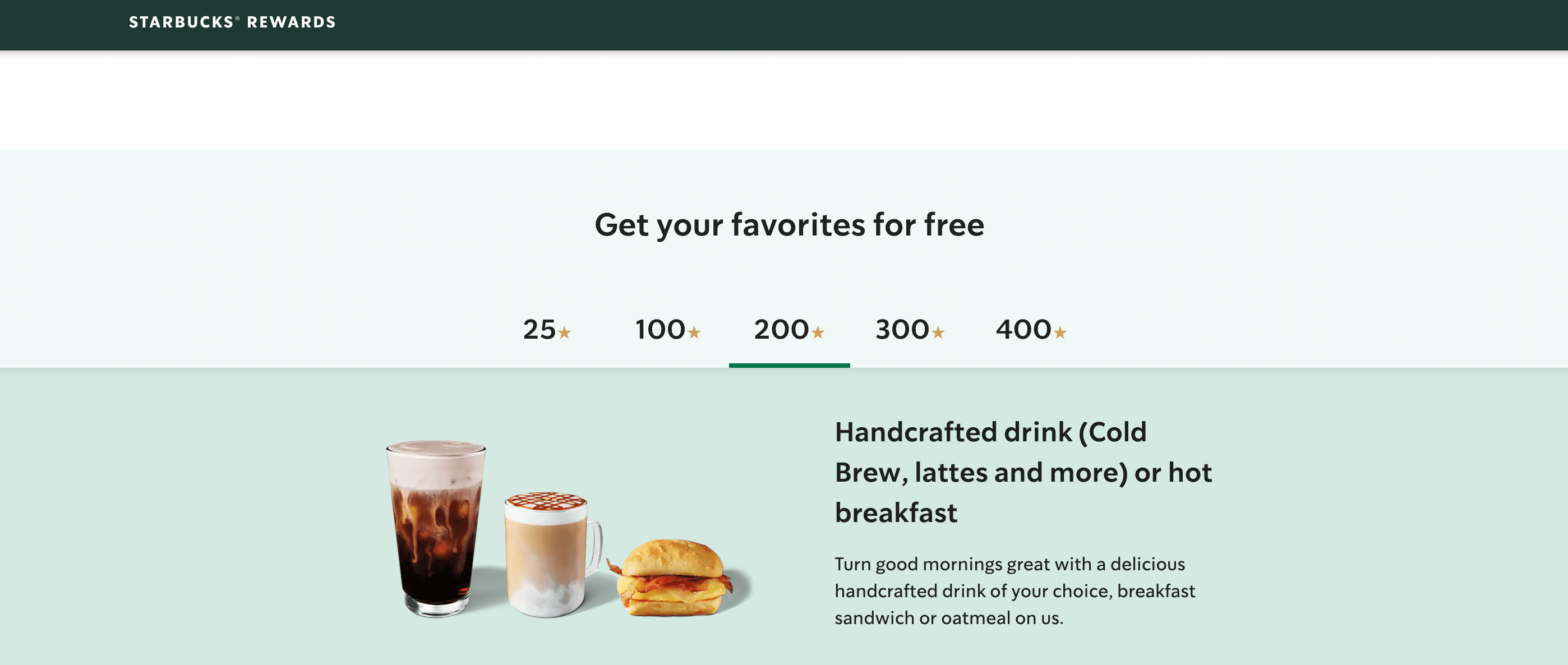
Starbucks currently has five tiers of different rewards customers can redeem. If Starbucks turned those five tiers into different levels of earnings, meaning each level would double the points earned, it would incentivize customers to spend more to enter and remain in a certain tier. Customers love an incentive or something to reach for and if Starbucks brought their famous gold card back, this would be a perfect way to entice customers into different tiers for their reward program.
How Starbucks Rewards raises the bar-ista
For a loyalty program contributing 55% of the company’s revenue, Starbucks has clearly locked in loyalty and a brand community. With an increase in prices in every industry, loyalty has become a key to growth and recession-proof for Starbucks. So what is Starbucks Rewards doing so well?
1. Outstanding mobile experience
Starbucks has become a global brand worth billions of dollars and we can take lessons on what great things they do in loyalty and rewards. Their top quality is their outstanding mobile experience.
How a customer interacts with a loyalty program can often make or break that program. Starbucks’ app makes its loyalty program more interactive and more effective. The app makes it easy to see how many “stars” (points) you currently have, as well as make orders and payments right from your phone. You can even use the service to find the nearest Starbucks location.
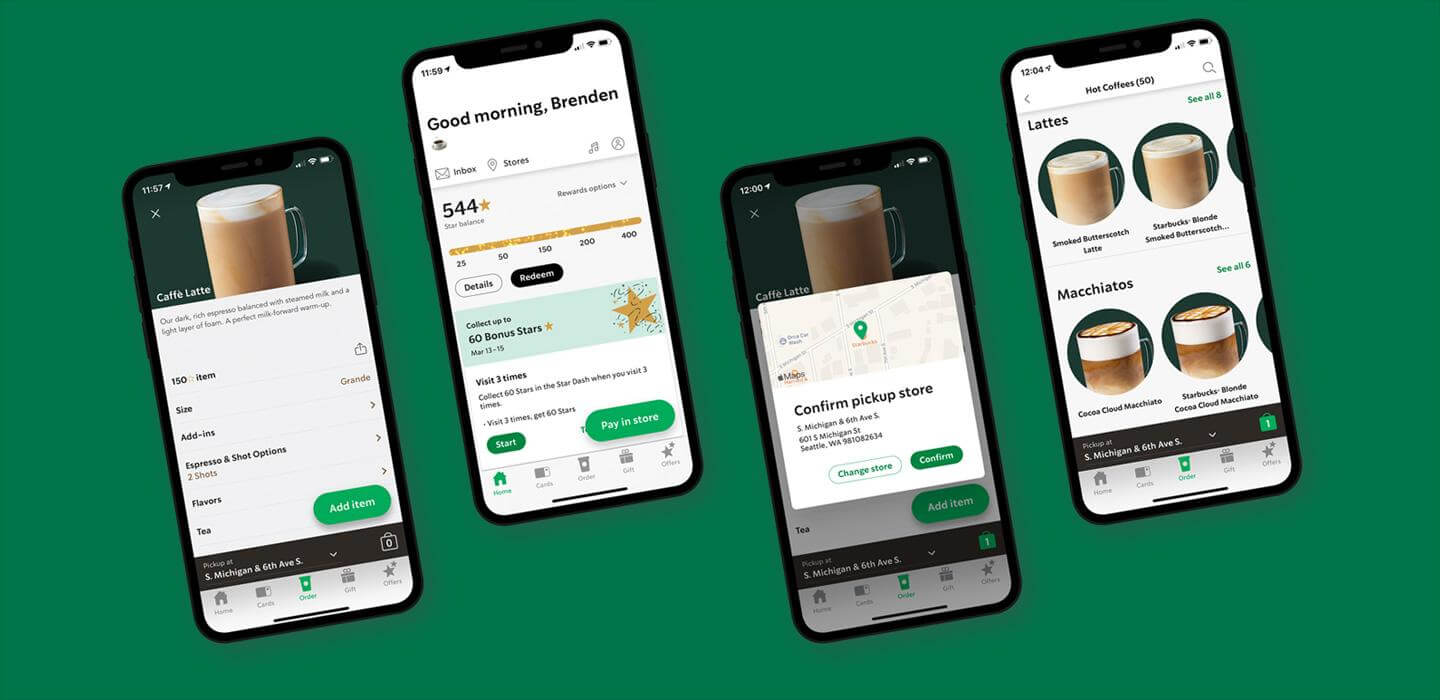
Starbucks mobile app, drive-thru, and deliveries generate over two-thirds of orders and up to 26% of sales from mobile apps alone. The app gives Starbucks Rewards an edge that other standard loyalty programs do not have. In today’s competitive environment, just having a loyalty program is not enough. You have to make an effort to differentiate your program from others.
2. Omnichannel retail
This leads to the second top quality of Starbucks Rewards and that is their omnichannel presence throughout the apps and physical retail locations and across their marketing. Not only can you pay on a mobile device or through in-store locations, but you can also shop online, order drinks through the app, or have an experience visiting different locations in any country. You know what you will get no matter where you are in the world.
From the rise of new services such as BOPIS (buy online, pickup in-store) to the conveniences of ordering from an app. Surprisingly, how we collect and receive our purchases are also different. Starbucks has expanded into delivery through its partnership with DoorDash which it tested in California, Florida, Texas, and Georgia last fall.
3. Experimenting with partnerships
The third top quality and characteristic of Starbucks Rewards are its partnerships. Starbucks has recently been experimenting with new partnerships in loyalty programs, going a step further with established brand partnerships. After testing its delivery partnership with DoorDash , Starbucks will expand nationwide in all 50 states by March 2023.
View this post on Instagram A post shared by Starbucks Coffee ☕ (@starbucks)
Starbucks is expanding into the NFT market with its program Odyssey. According to Starbucks, ”selected participants will be able to engage in Starbucks Odyssey ‘Journeys’ which are a series of entertaining, interactive activities to earn collectible ‘Journey Stamps’ (NFTs) and Odyssey Points that will unlock access to exciting new benefits and experiences.”
View this post on Instagram A post shared by Delta Air Lines (@delta)
What’s better than one loyalty program? How about two loyalty programs? For those frequent travelers, Starbucks and Delta announced a partnership where members can link both of their loyalty programs and earn points. “Link your Delta SkyMiles and Starbucks Rewards accounts to start earning 1 mile per $1 spent at Starbucks.” This is another way Starbucks can in a way gamify their loyalty program, while also offering more to its customers.
Gold Stars for Starbucks Rewards
With almost 30 million program members, Starbucks Rewards is a top standard for loyalty programs that any ecommerce business can take lessons from and be on their way to replicating. Whether it's building an awesome omnichannel strategy or delivering a fantastic mobile experience or partnering with other brands in your industry, Starbucks can deliver lessons to all of us.
Editor’s Note: This post was originally published on July 24, 2017 and was updated for accuracy and comprehensiveness on March 13, 2023.
You might also like
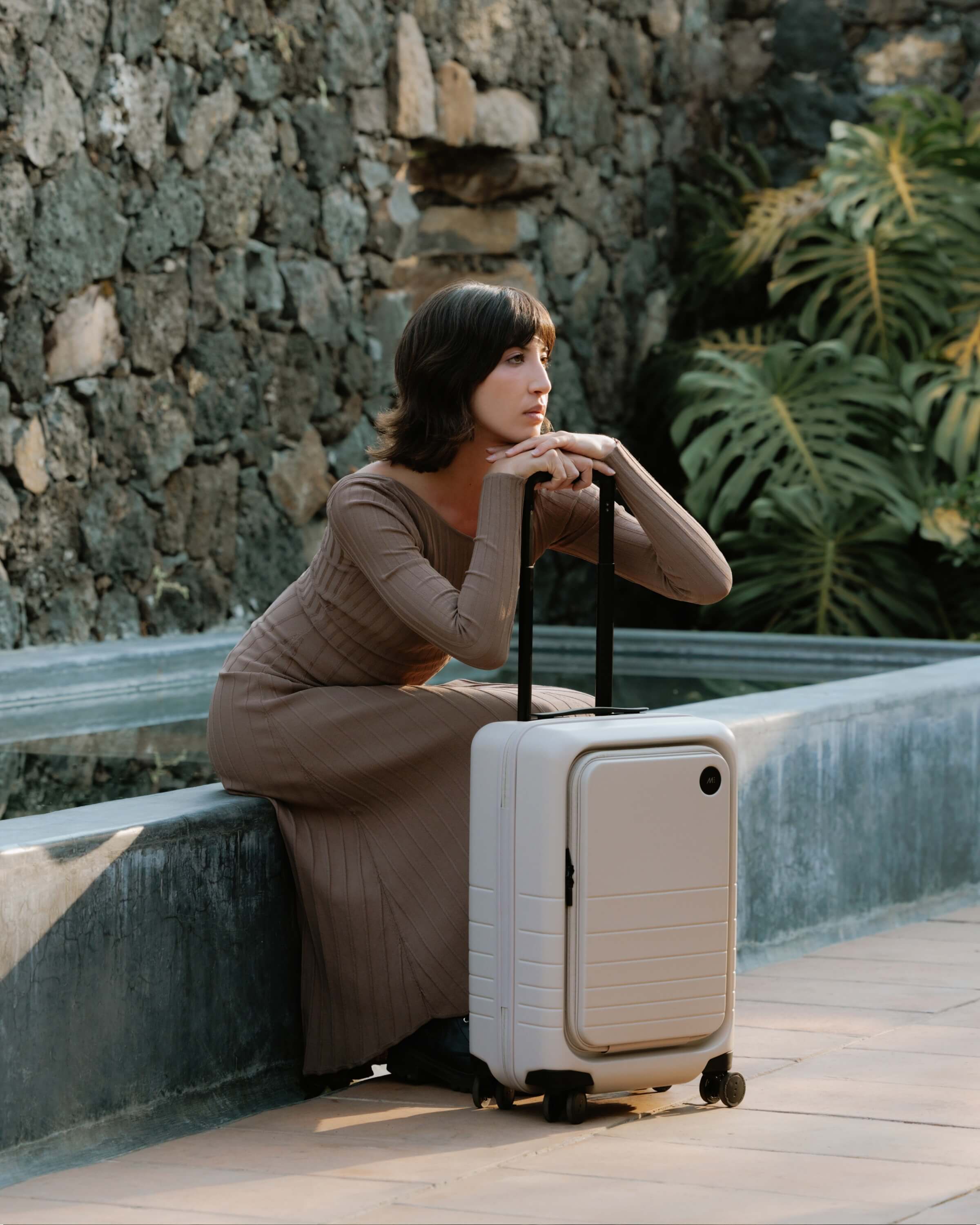
How Monos Unlocked $8M with their Loyalty Retention Strategy
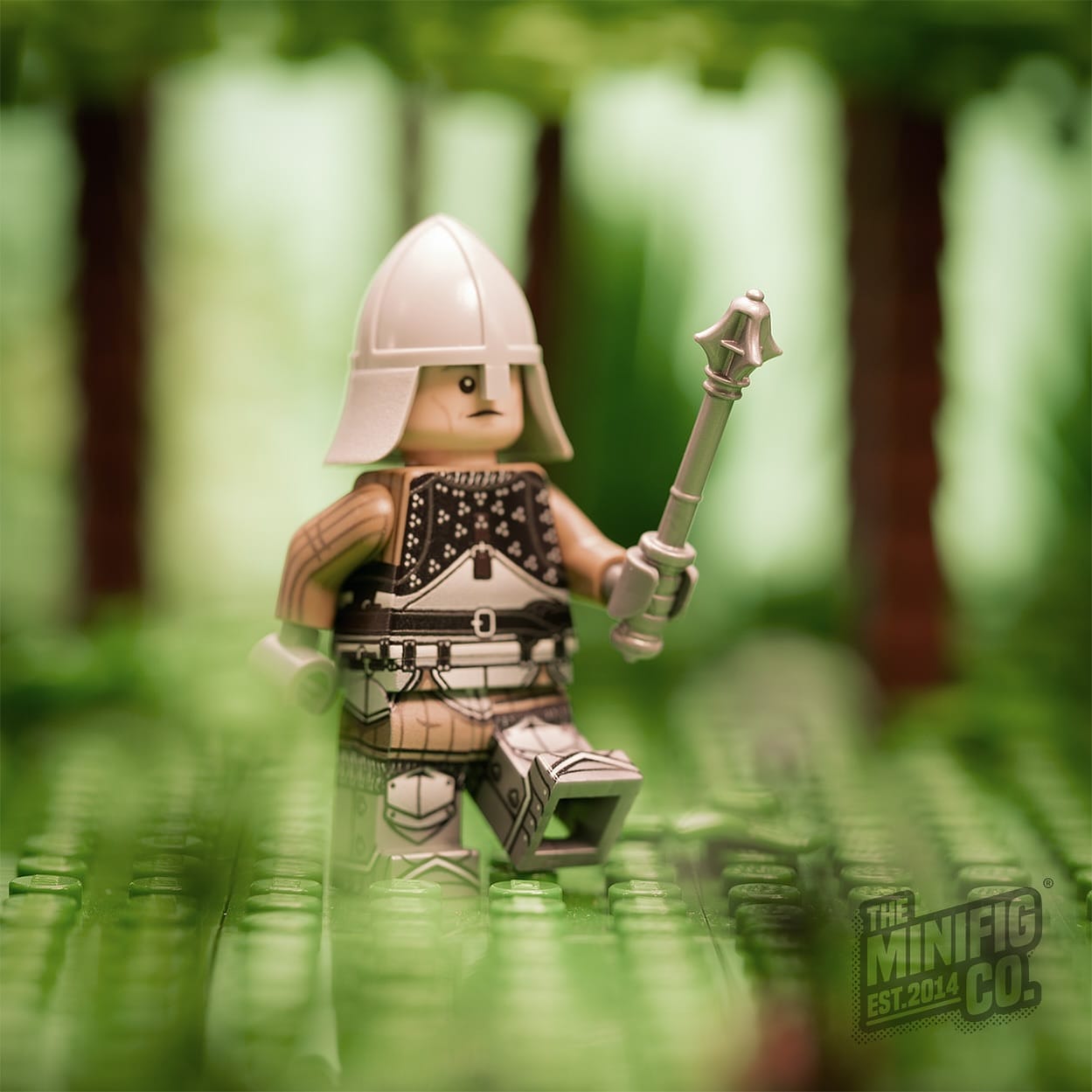
How The Minifig Co. Uses Embedded Loyalty to Drive Sales
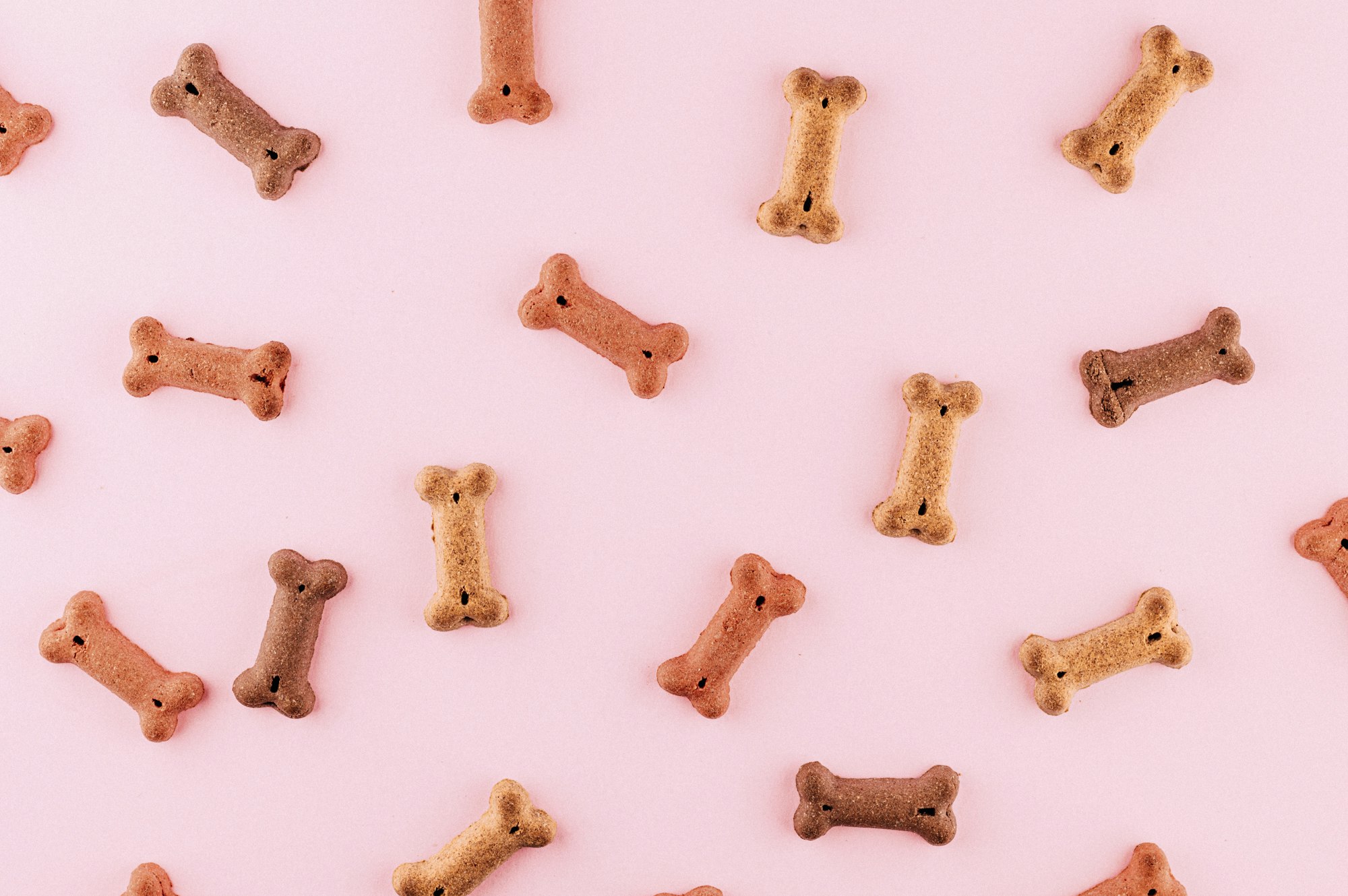
Rewards Case Study: PetSmart Treats Rewards (+How to Recreate the Program)
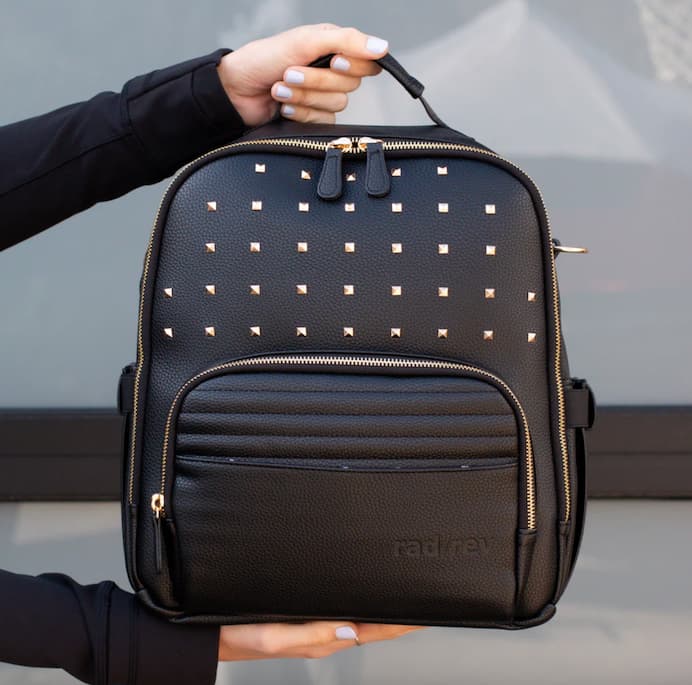
How Rewards Influenced $200K+ in 1 Year for Rad Rev
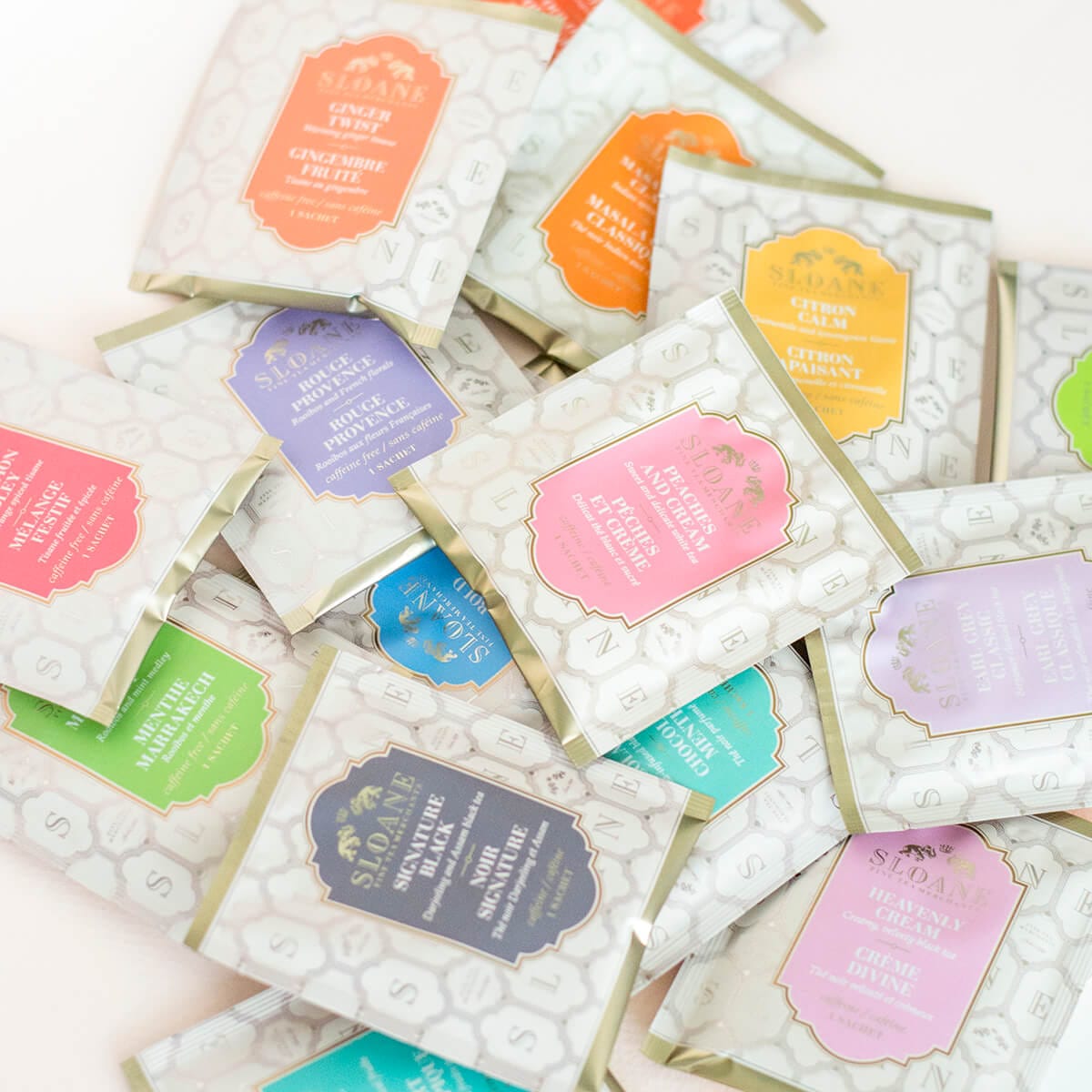
How Sloane Tea Boosted Revenue by 370% in 24 Hours with Bonus Points
Subscribe to the smile newsletter.
- Request a demo
- Contact sales
- Start free trial
Starbucks Loyalty Program Case Study

Starbucks, renowned as one of the foremost coffee brands globally, owes its success not just to its exceptional range of products. A significant contributor to its widespread acclaim is its highly popular loyalty program , which has been an inspiration for many U.S. restaurant chains and retail stores. Launched on December 26th, 2009, the Starbucks rewards program has amassed over 30 million active members, contributing to nearly 60% of the brand's total revenue. The program effectiveness was strikingly evident in 2019, with Starbucks reporting a substantial 7% increase in sales primarily attributed to the efficacy of its rewards program.
Program type
Points system.
- Points for rewards
- Coalition Loyalty
Starbucks Rewards leverages a points-based system ingeniously designed to enhance customer engagement and loyalty. Members accumulate 'Stars' with each purchase made via their registered Starbucks Card or through the Starbucks mobile app. The program is structured to encourage varied forms of engagement, enhancing the overall customer experience and brand loyalty.
- Earn 1 Star per $1 spent when you pay in cash
- Earn 2 Stars per $1 spent when you preload your digital Starbucks Card
- Earn additional bonus Stars through special promotions
- Earn double Stars on Delta Airlines travel days
- Earn double Stars on promotional days
- Points expire after 6 months
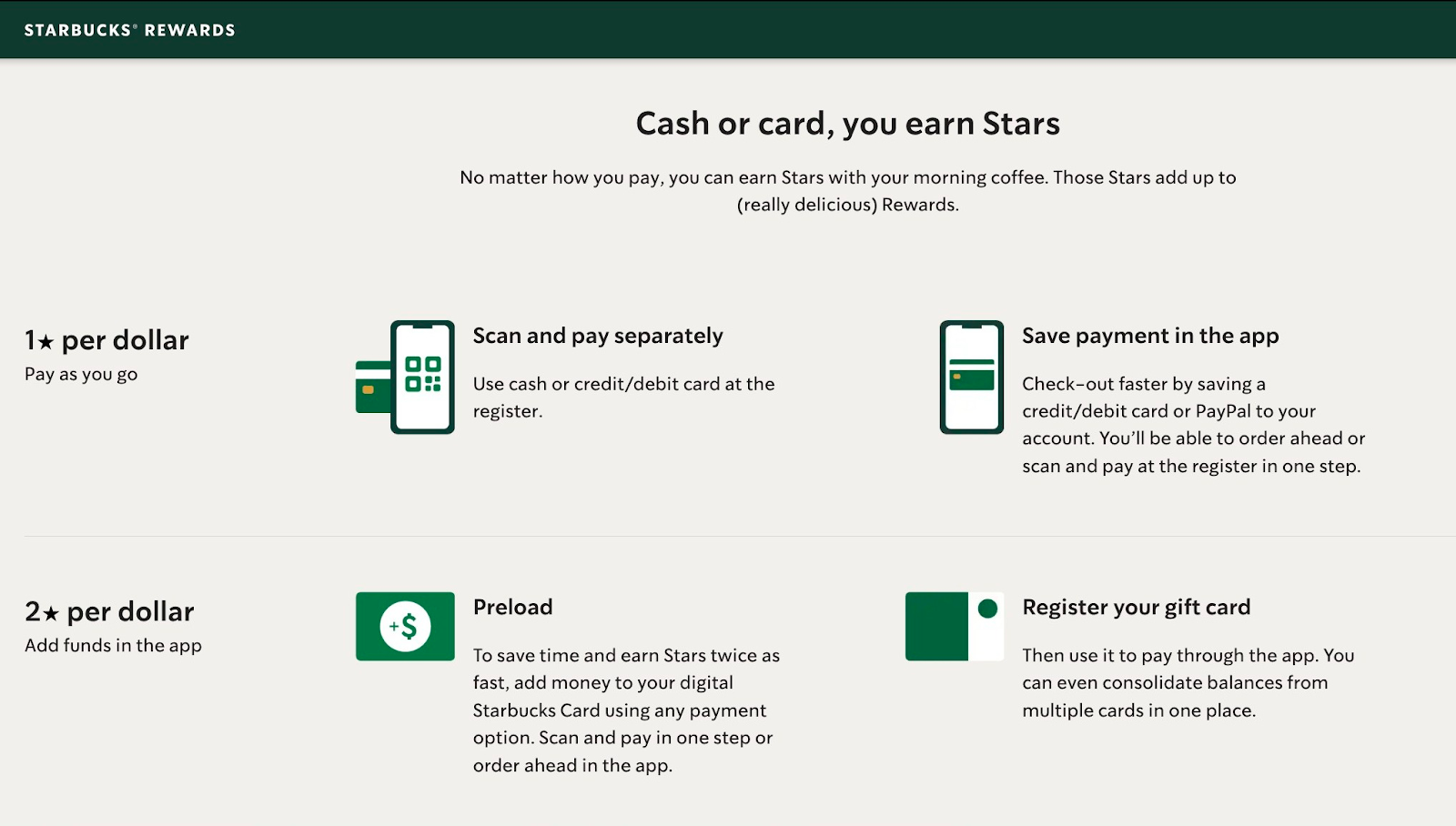
Starbucks Rewards allows its members to redeem their accumulated Stars at various levels, each unlocking distinct rewards. This structure caters to diverse preferences, allowing customers to either redeem their Stars for immediate benefits or save them for more substantial rewards.
- 25 Stars: Redeem for a free drink customization, such as extra flavor, espresso shot, or alternative milk.
- 50 Stars: Get a complimentary hot coffee, tea, or bakery item like a bagel or croissant.
- 150 Stars: Choose a free handcrafted drink, hot breakfast, or a parfait.
- 200 Stars: Earn a complimentary lunch item, like a salad, sandwich, or protein box.
- 400 Stars: Exchange for packaged coffee beans or select Starbucks merchandise.
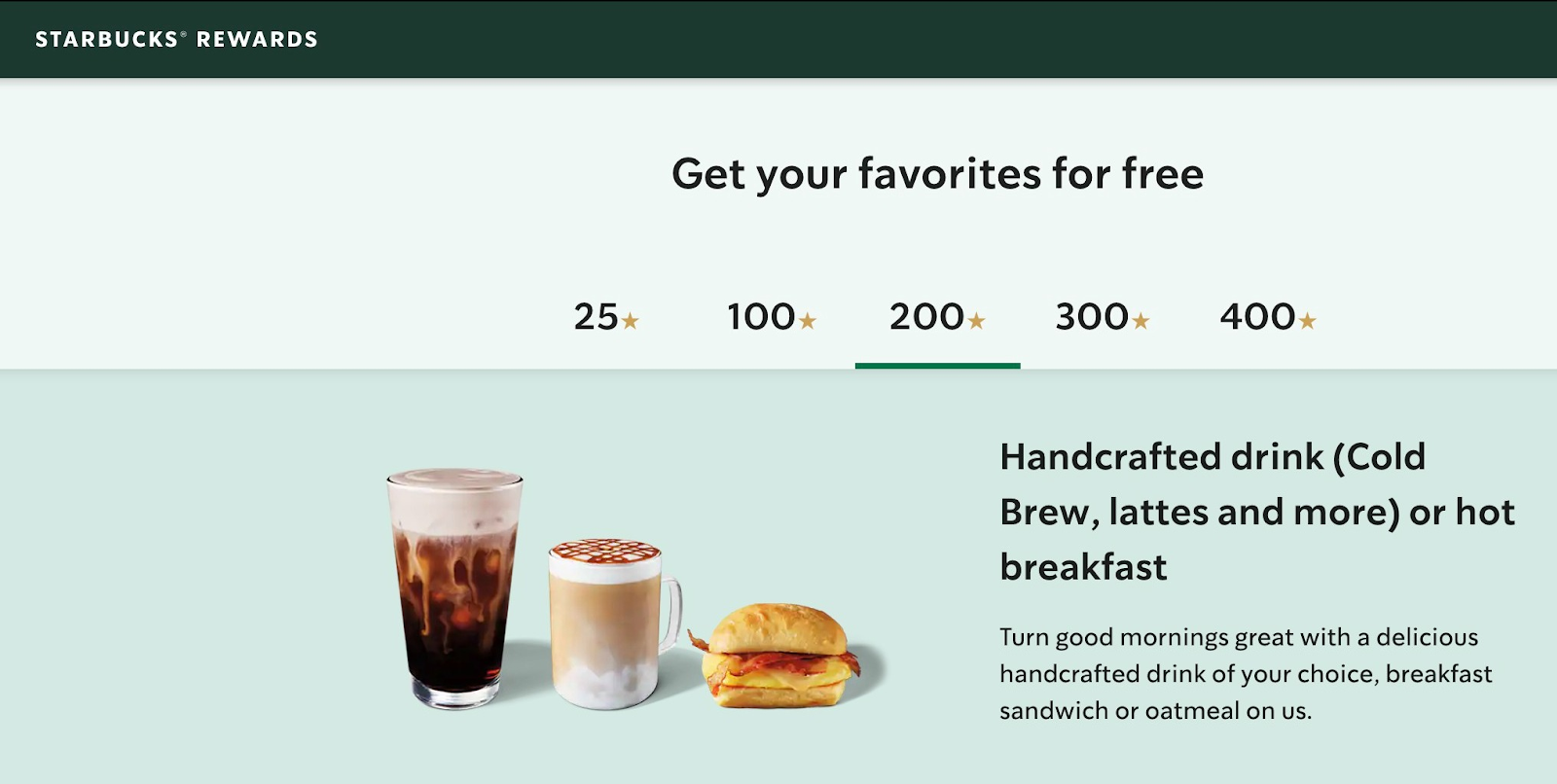
Coalition loyalty
Starbucks and Delta Airlines have embarked on a partnership, merging the world of coffee with the skies. Linking your Delta SkyMiles® and Starbucks® Rewards accounts opens up a new realm of earning opportunities and exclusive benefits.
- Travel-day perks: Double Stars on Delta travel days
- Everyday earn: 1 mile per $1* spent at Starbucks
- Exclusive offers: More opportunities to earn Stars and miles
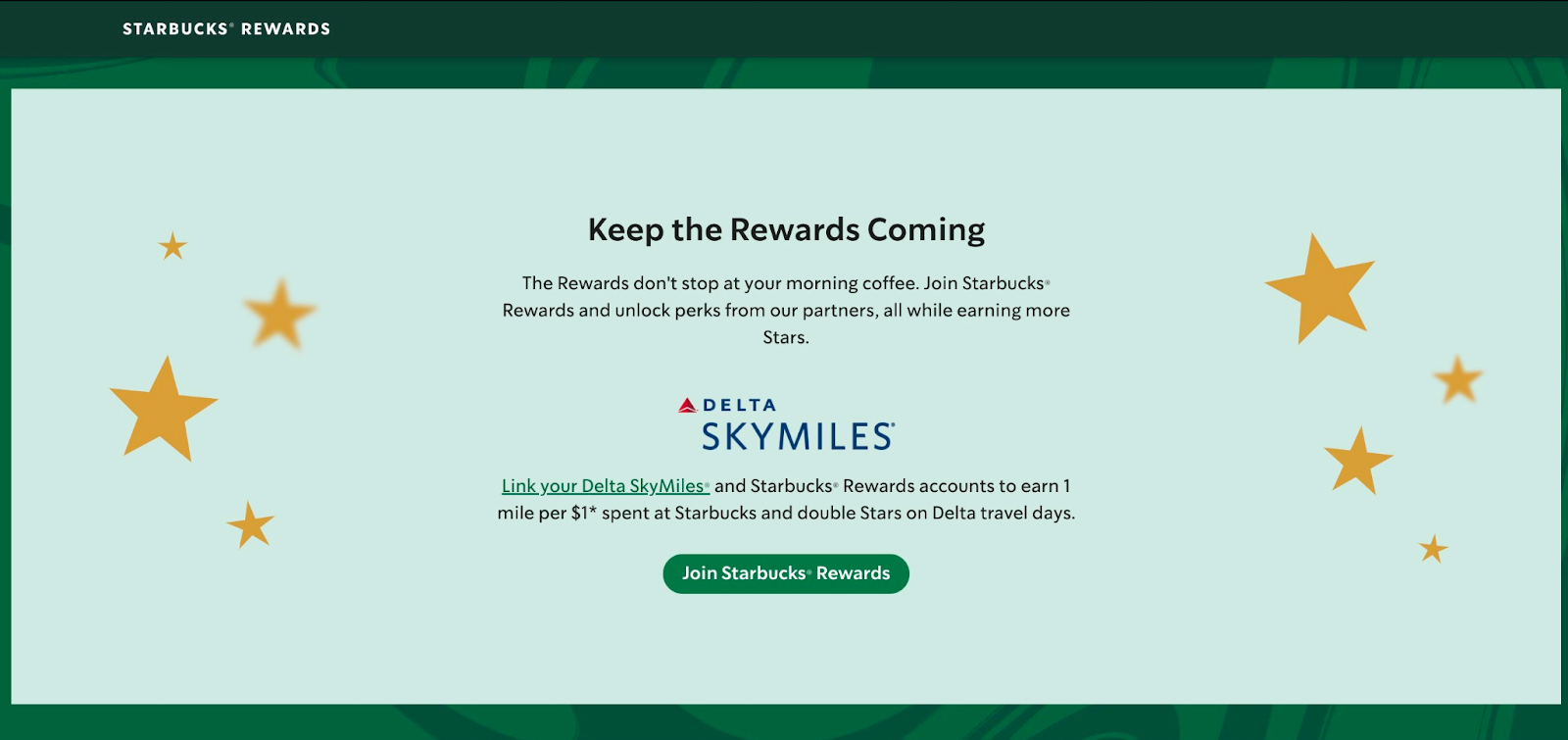
Interesting takeaways
Multi-channel communication.
Starbucks leverages multiple channels to communicate about its rewards program, ensuring widespread awareness and engagement. The use of a dedicated landing page, mobile app, points balance reminder emails , company blogs, and social media platforms creates an ecosystem where information about the program is readily accessible and consistently updated. The clarity and frequency of updates, including press releases for significant changes, demonstrate Starbucks’ commitment to transparency. This approach not only keeps existing members informed but also attracts new participants by clearly outlining the program’s benefits. Good communication is likely a significant factor in the program's high membership numbers.
Program simplicity and incentive structure
The simplicity of the points system (earn points and redeem for rewards) is user-friendly and easy for customers to grasp. This clarity enhances the appeal of the program and encourages participation. The structured nature of rewards incentivizes customers to accumulate more points to access greater rewards. This gamification element adds an extra layer of engagement, as customers are motivated to reach the next level. As customers get closer to a significant reward, their motivation to attain it increases. This psychological aspect of goal setting and achievement is a powerful tool in enhancing customer loyalty and encouraging more frequent purchases.
Incentivizing preloaded payments
Starbucks ingeniously incentivizes customers to preload their Starbucks account by offering double points for purchases made using a preloaded Starbucks Card. By preloading their accounts, customers commit themselves financially to future purchases at Starbucks, which effectively guarantees a degree of customer loyalty and repeat business. This strategy turns occasional visitors into regular customers, as the preloaded funds will likely be used exclusively at Starbucks locations. From a financial perspective, this strategy is beneficial for Starbucks. When customers preload their accounts, the brand receives cash in advance, improving its cash flow. This tactic also promotes increased engagement with the Starbucks mobile app, where preloading and tracking of rewards can be easily managed.
Coalition program with Delta Airlines
The partnership with Delta SkyMiles is a strategic move that broadens the program’s appeal. By collaborating with an airline, Starbucks extends its reach beyond the typical coffee shop customer. This alliance allows both companies to tap into each other’s customer bases, potentially attracting new customers who are loyal to one brand to become interested in the other. It’s a creative way to expand market reach without direct competition. For customers who already patronize both brands, this coalition loyalty program reinforces their loyalty and increases their engagement with both Starbucks and Delta. It creates a more integrated customer experience and can deepen the sense of brand loyalty.
Areas of improvement
The removal of the tiers system.
The previous iteration of the program had a 'Gold' tier, which was a smart way to acknowledge and reward the most loyal customers. By offering them the ability to earn points faster and providing exclusive benefits, Starbucks recognized and cherished its most valuable customers. This tier system not only incentivized increased spending but also gave a sense of exclusivity and status. While simplifying the program might make it more accessible for new customers, it risks diminishing the perceived value for power shoppers. The elimination of the tier system could lead to a decrease of engagement from these highly valuable customers.
Lack of personalized engagement or rewards
In the current market, personalization is key to customer engagement. Starbucks’ generic approach to rewards and communication, without considering individual customer preferences and behaviors, is a missed opportunity. Personalizing rewards and communications could significantly enhance customer loyalty and encourage repeat business. Leveraging customer data to offer personalized rewards and product recommendations could not only improve customer satisfaction but also drive product discovery and sales.
Limited post-purchase engagement
Post-purchase engagement is crucial in maintaining a connection with the customer even after they leave the store. This ongoing engagement is essential for converting first-time buyers into regular customers. While Starbucks has started initiatives like Starbucks Odyssey , which offers additional ways to earn rewards through digital journeys, its integration with the main rewards program appears to be lacking. A more seamless integration could enhance the overall experience and effectiveness of the loyalty program. Recognizing that some of these initiatives are in their early stages, there is potential for growth and improvement.
Learn from our library of loyalty program case studies
Similar Readings
Ready to grow your business.
This site uses cookies to store information on your computer. Some are essential to make our site work; others help us improve the user experience. By using the site, you consent to the placement of these cookies.

Digital Innovation and Transformation
Mba student perspectives.
- Assignments
- Assignment: Digital Winners and Losers
Starbucks: Winning on rewards, loyalty, and data

Starbucks Rewards Program generates customer loyalty, increased revenue, and data for the company to create meaningful 1:1 relationships and personalized marketing efforts.
Starbucks Reward Loyalty Program
The Starbucks Reward Loyalty Program has a staggering 16 million active members (as of March 2019), with 11% growth of their user base in Q2 2018. Starbucks attributes 40% of its total sales to the Rewards Program and has seen same store sales rise by 7%. The Reward Program is available on mobile devices as the Starbucks app, and has seen impressive membership and growth since 2008, with multiple iterations on its original form. The investment made into the mobile interface has increased the frequency and spend of both regular and occasional customers. Starbucks uses this tool to individually market specific products and features based on data collected from the app about its users. Customers can order and pay through the app ahead of arriving at a physical location, as well as earn stars (rewards) that translate into free drinks, food, and merchandise. Starbucks is a clear winner that has reinvented their relationship with customers and captured enormous value through their investment into digital technologies.
How does Starbucks create value?
Customers benefit from using the app by:
- Ease of payment in store through mobile app
- Ability to order and pay ahead of arriving in store (and therefore skip any Monday morning rush lines by having a separate ‘mobile order pickup’ station – which in itself serves as a highly effective marketing tool for the app)
- Rewards and benefits: such as free refills on brewed coffee and free drinks on member’s birthdays, relatively quickly earned other rewards from purchases, such as free food/drinks/merchandise
- Special member events
- Ability to send other members and friends gift cards through the app
- App integration with other platforms such as Spotify to discovery music playing in store (a big part of Starbucks and more generally coffeehouse culture)
- Members are first to know about upcoming seasonal and new product releases
Starbucks reaps many of its own ‘rewards’ from the app:
Pathways to a Just Digital Future
All these features have created an intense loyalty for customers to the app and reward program, which kicks back nicely for Starbucks. Members of their rewards program are feeding in valuable data that Starbucks can then mine to personalize marketing efforts to individuals and create a uniquely direct relationship with their customers. Besides drawing in the ‘occasional user’ to come back and increase their frequency of purchase (key in this business), the app has also been seen to increase the frequency and spend of regular and super-user customers. According to CFO Patrick Grismer, “We know from our experience that when customers join our rewards program, their total spend with Starbucks increases meaningfully”.
Aside from the increase in revenue associated with the app, the real value lies in the innovative potential uses for the large amounts of user data collected, which forms the base of Starbucks’ digital strategy. Starbucks has begun experimenting with digital menu boards in their physical locations to allow for a dynamic menu based on customer demand (varying with regional preferences and times of day), that would ideally continue to boost same store sales. The decision of where to place new stores and how to expand has also been informed by this user data. The ways in which this user data can be used in the future are important in the ever more personalized retail world, where customers want less of being ‘talked at’ and more of being included in a conversation.
What’s Next?
Starbucks continue to prove itself to be truly customer centric, building innovation around the core theme of their relationship with customers. Their willingness to adapt and invest in their digital technology has allowed them to create and capture enormous value for both customers and the company. As Starbucks gets access to more customer data, the ability to continue to create more meaningful, personal relationships with customers will only increase, and this is how Starbucks is positioned to win in the future. They have continued to innovate on ease of use with the app, now integrating voice as a feature when ordering for mobile pickup. Of course, Starbucks will have to continue within this theme of digital innovation to remain a winner in the future. Use of consumer data builds a strong base for a number of potential technologies to harness in the future, but it doesn’t guarantee success.
https://www.e-zigurat.com/innovation-school/blog/companies-digital-transformation-strategies/
https://www.restaurantbusinessonline.com/marketing/starbucks-rewards-program-pushes-chains-growth
https://www.usatoday.com/story/money/2019/03/19/starbucks-redesigns-its-loyalty-program-so-you-get-free-stuff-sooner/3174227002/
https://zinrelo.com/loyalty-rewards-case-study-new-starbucks-rewards-program.html
https://themanifest.com/app-development/success-starbucks-app-case-study
Student comments on Starbucks: Winning on rewards, loyalty, and data
I loved this post, Leah! (Not just because I’m a Starbucks junkie and heavy user of the app.)
One thing that I think about whenever I use mobile ordering is the way my experience has changed in the store – I spend less time on the transaction, keep my headphones in, and don’t have to interact with anyone behind the counter. This is a huge positive for me (e.g., when I’m in a rush) and probably makes me lower cost-to-serve for Starbucks, but I wonder does the presence of in-and-out customers like me make non-mobile users’ experience worse? Are they served more slowly? Do they no longer enjoy lingering over a book in Sbux’s “third place” when there’s a constant stream of mobile customers with headphones in, coming and going? Maybe this is why Starbucks is doubling down on its Reserve Roastery high-end concept, to segment out the grab-and-go types like me from the coffee shop experience-seekers.
To generalize, it seems that greater investment in/growth of digital channels can negatively impact traditional channels if not addressed proactively.
Really good point!
Great article highlighting Starbucks, Leah!
Your blog post reminds me of our first case in class on Dominos Pizza. At one point, Dominos was considered a huge winner in the app/delivery space as they were an early adopter of app & ordering technology. But as competition moved quickly, other players such as UberEats and DoorDash threaten the competitive advantage these single-brand apps, such as Dominos, had developed. I sat in class wondering if Dominos could follow the Starbuck’s app model and develop a loyalty program, or if selling pizza vs. cappuccinos are just too different of business models?
Interesting read! I think the membership programs that have become increasingly common in retail are an interesting way for traditionally analog companies to begin to experiment in the digital world. There is clearly value on the table for both the company and the consumer so I can imagine it would be an easier internal sell than some other digital transformation projects. I wonder how Starbucks will continue to improve their application to build an experience that connections the physical and digital worlds for their consumers and differentiate against other big chain coffee shops.
Thanks Leah for the interesting post. I completely agree that the reward loyalty program is an effective initiative to reduce the customer churn due to the entry of new coffee players. However, I believe that it is even more important to improve the customer experience by creating new products that match with the evolving preferences of customers. As you mentioned in the article, data will play a critical role in the future to offer a more personalized service. Starbucks has developed some initiatives in this line. For example, in 2019 Starbucks installed 1,900 Mastrena II expresso makers, which have IoT sensors for preventive maintenance purposes. This initiative will allow Starbucks to reduce machines’ failures, reduce customer wait time and improve customer experience. In the future, Starbucks should continue working with data to improve their products and increase customer retention.
Great analysis Leah and really unique viewpoint on what’s next for Starbucks! As brands continue to focus on building a deeper connection with their consumers loyalty programs that collect more personalized data and usage trends will help organizations better differentiate their service and product offerings. I am curious as Starbucks begins to really leverage big data what major changes do they decide to implement. There may be opportunities to decentralize operations and curate offerings providing localized products, location designs, and services which can further help Starbucks capture a larger share of wallet.
Great post, Leah!
I feel conflicted about Starbucks’ shift to the digital channel that allows for a greater number of customers to be served in a shorter amount of time. Personally, I’m the type of customer that spends hours at coffee shops for the quiet and relaxing ambiance, smell of coffee, and calming music. These days, Starbucks stores feel more like McDonald’s and the relaxing user experience has been completely lost. While they’ve now lost me as a customer, I recognize that they’ve gained 8 in my place that probably result in higher profitability. A win for Starbucks, but unfortunately a loss for me.
Great post! This is super interesting to me – I had no idea this was such a powerful tool. There is one main thing I’m wondering about: What do you think allowed Starbucks to be more successful than other coffee shops with their Rewards program? Was it more the technology, the convenience, the recommendations, or the combination of everything together? I guess my thought is that I don’t know why more companies haven’t been able to replicate this.
A second thought is just that the power of this loyalty seems so strong that it may be impossible to disrupt, despite lower prices elsewhere. We see new coffee shops popping up all the time, and I’m not sure any of them stand a chance knowing this.
Thank you for sharing! This has opened my eyes to how important loyalty is and how brands can work on building that with customers.
Leave a comment Cancel reply
You must be logged in to post a comment.
Increasing returning customer rate
Reaching new customers
What your customers see
Tools to optimize your program
Next-level connections with your other tools
Customize your program with diverse rewards
Get actionable customer insights
Proven value for your business
Expert help to guarantee success
See LoyaltyLion in action
Advanced loyalty solutions
Learn how to use LoyaltyLion
Integrate with or build apps on top of LoyaltyLion
Your questions answered
The latest loyalty updates and guides
Discover our successful loyalty program merchants
Top 30 Shopify loyalty programs in 15 categories
Hear from industry experts and leaders
Join us at Loyalty Connect: Autumn Edition, LoyaltyLion’s virtual summit
Partner with the #1 loyalty platform- as voted for by our customers on G2!
- Food and beverage
- Health and wellness
- Sport and outdoors
- Home and garden
- Loyalty and rewards
- Referral program
- Shopper experience
- Rules and automation
- Integrations
- Loyalty page
- Customer analytics
- ROI calculator
- Product tour
- For bigger brands
- Help centre
- Developer portal
- Case studies
- Award-winning programs
- Loyalty Connect: Autumn edition
- Partner with LoyaltyLion
20 examples of successful loyalty programs in 2024 — and what makes them work
Done right, loyalty programs are a uniquely effective way to improve customer retention.
Research from Accenture found that loyalty program members drive between 12 and 18% revenue growth each year.
There are countless examples of brands that have seen big results. Although many of them make it look easy, their success is down to a keen understanding of what customers want from a loyalty program , and, by extension, what kind of loyalty scheme will resonate.
It’s not a one-size-fits-all approach, and the options for structuring loyalty offerings are ever more varied. The humble loyalty card is still often effective, but online loyalty schemes present innovative and intricate ways to encourage and track loyal customer behavior.
So let’s dig beneath the shiny numbers of some of the world’s most popular and successful consumer loyalty programs and see what makes them work.
20 examples of the best customer loyalty programs
- Sephora’s “Beauty Insider Program”
- “LEGO Insiders”
MoxieLash Insider
- Astrid & Miyu’s “Astrid & You”
- Barnes & Noble
Amazon Prime
- Pulse Boutique’s “Pulse Perks”
- Annmarie’s “Wild and Beautiful Collective”
Pacifica Beauty
- The North Face’s “XPLR Pass”
- REI’s “Co-op membership”
Lucy and Yak
Nicce clothing, the four main types of loyalty program (and examples of each).
There are four main kinds of loyalty program :
- Points-based
- Value-based
- Subscription
Each has been used to great effect. Here’s why the best have succeeded (and why others might fail).
Examples of loyalty point programs (“earn and burn”)
Points-based loyalty programs reward customers with points for purchases, which can be redeemed for discounts, exclusive products or other rewards.
Sephora’s “Beauty Insider”
One of the most lauded points-based loyalty programs is Sephora’s Beauty Insider Program .
Using their points, members have the chance to test a range of “trial-sized” products and unique experiences – such as full-face makeovers.
This works particularly well in the beauty industry , where creativity and experimentation are so fundamental.
Sephora also capitalizes on the community-driven nature of the beauty industry — Reddit’s r/makeupaddiction community alone has over 4 million members — with its “ Beauty Insider Community ”, a space that lets beauty lovers find their inspiration and seek advice from other members.
The French retail brand stays ahead of the curve by getting one vital thing right: it continues to transform and tweak the loyalty reward program to best meet the ever-changing needs of its customers. And that’s a great way to stop them from losing interest.
Although largely points-based, Beauty Insider is actually a hybrid loyalty program : its points-based structure is complemented by loyalty tiers. In the US, the tiers are “Insider”, “VIB” and “Rouge”. As well as tapping into the usual benefits of tiered loyalty programs, this encourages further discussion and engagement online, with a number of Reddit threads about the best ways to use Sephora points.
In July 2024, Sephora launched a tiered loyalty system in the UK — “MySephora Bronze”, “MySephora Silver” and “MySephora Gold”.

Another classic example of a points-based loyalty program is the loyalty card. You buy your items in a store, scan your card, and receive points based on the total value of your purchase. It’s a simple, clear reward that plays especially well in those industries where purchases are frequent and increasing average order value is a priority.
Examples of value-based loyalty programs
Value-based loyalty programs are a bit like points-based ones, but points can be earned in other ways than just making purchases.
LEGO Insiders
The LEGO Insiders program , for example, rewards customers not just for purchases, but also for registering LEGO sets and getting involved in the customer community.
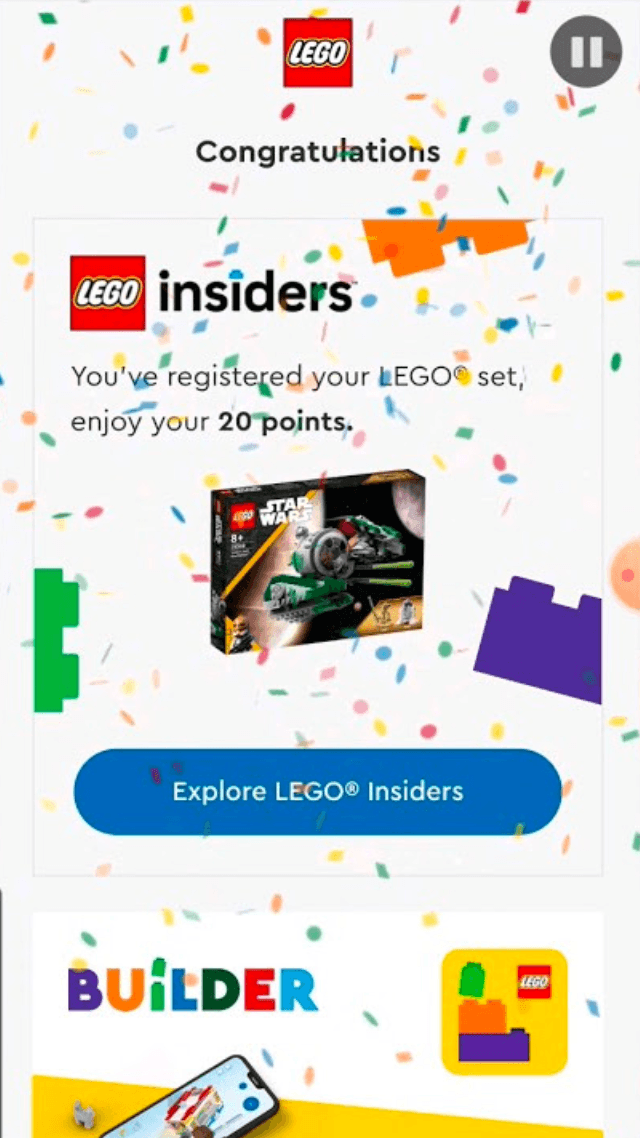
It works because LEGO enjoys such a strong emotional connection with its customers. People love their LEGO, and the company maintains this sense of reciprocity through initiatives like LEGO Ideas, through which customers’ original designs can be turned into official products via a voting process.
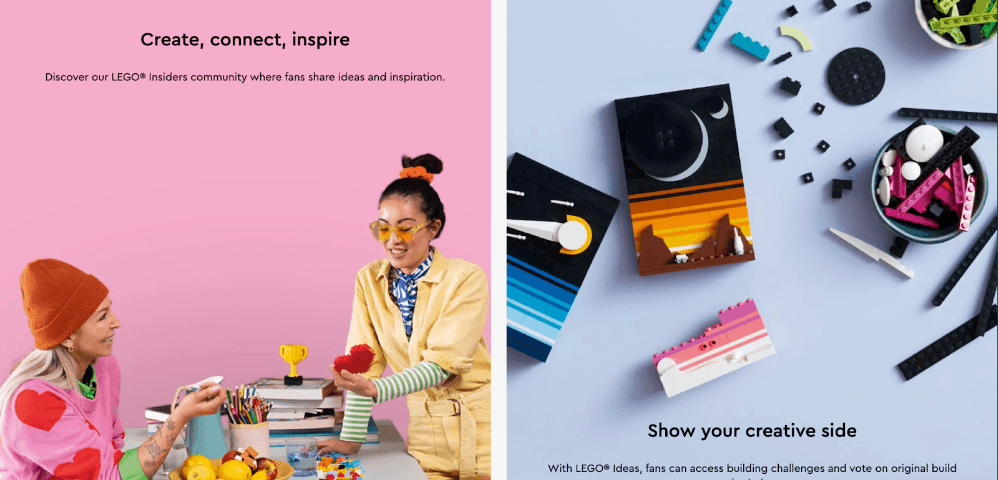
Building this kind of loyalty is incredibly valuable for a brand that sells high-ticket items, and for which increasing purchase frequency is essential.
Like Sephora, LEGO Insiders also generates more engagement and discussion online. In this Reddit thread , LEGO enthusiasts speculate on an upcoming offer, which does wonders for building hype around the reward program.
The MoxieLash Insider program is another excellent example of a retail brand using a value-based loyalty program. Like Sephora, they understand the value of building a community of advocates, especially on social media , where a highly visual product like theirs plays particularly well.
That’s why they offer points not just for purchases, but for social media engagement and app downloads. They know that, in their case, the downside of giving product discounts for non-transactional activities is more than offset by the benefits of social media engagement.
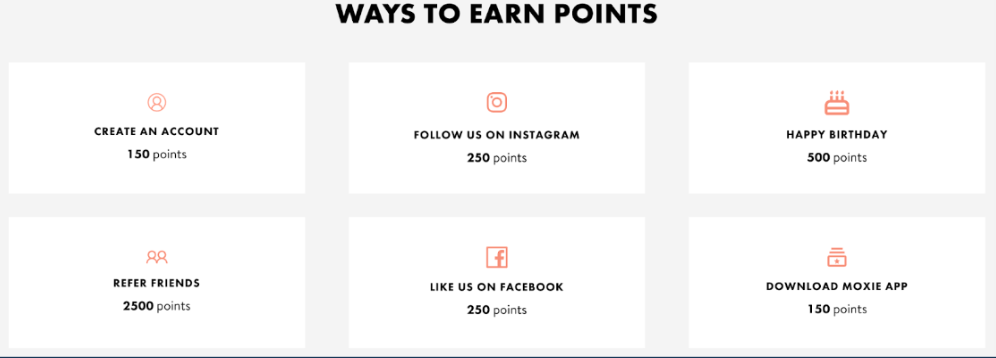
Examples of tiered loyalty programs
Tiered loyalty programs involve levels of membership that offer increasing rewards and benefits based on customer spending or engagement.
They’re usually more complex to manage, but they can be more effective at creating customer loyalty.
Tiered loyalty programs are particularly well-suited to high-end, luxurious products, where the feeling of exclusivity can heighten the sense of luxury.
Astrid & Miyu’s “Astrid & You”
Astrid & Miyu’s loyalty program Astrid & You is a great example. At the silver and gold tiers, customers get early access to sales and promotions. At gold, they get £20 off on their birthday.
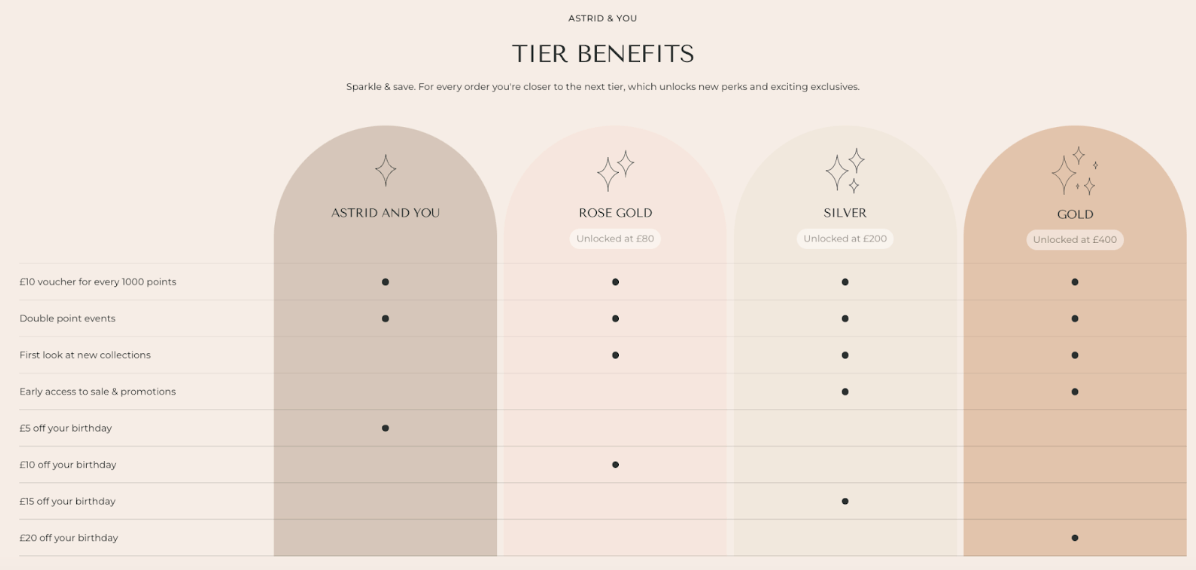
Hospitality companies tend to use tiered loyalty programs, too. Hilton Honors is a notable example.
Tiered loyalty programs are particularly effective in industries with fluctuating demand. Where purchases are frequent and consistent, and average order values low (as is the case for many retail brands), exclusive tiered benefits can be less of an incentive to make repeat purchases.
What makes these tiered loyalty programs so effective is that they understand their status as “luxury” purchases in the eyes of potential customers , and that therefore they might have to work harder to incentivize repeat custom. At the same time, they recognise that it’s exactly this luxury status that makes exclusivity an enticing benefit.
Examples of subscription loyalty programs
With subscription-based loyalty programs, customers pay an ongoing fee to get access to perks, products or exclusive events.
Because customers have to pay up-front — rather than passively accruing points as they shop — it’s more difficult to enroll customers onto your loyalty program . The benefits have to be significant.
Subscription-based loyalty programs are best suited to frequent, less-considered purchases — such as books. Barnes & Noble Membership involves an annual fee for exclusive discounts, free shipping and special offers.
Similarly, Amazon Prime gives customers unlimited to extremely fast delivery for a set fee.
In commoditized markets like bookselling, where it’s difficult to compete without a race to the bottom on price, these bonuses tend to have a “lock-in” effect on customers. Once they’ve paid their membership fee, it’s a sunk cost, and they can choose between your next-day delivery or your competitor’s comparatively slow delivery.
Compare these industries to some of the luxury brands adopting tier-based loyalty programs. You’d have a hard time convincing someone to pay $10 a month for a subscription for a brand they purchase from a few times per year at most.
In Amazon’s case especially, subscription-based loyalty programs can also smooth the move into new markets. When the retail giant launched Prime Video, they had a ready-made audience of Prime customers ready to adopt it, and they could strengthen the loyalty program by adding it as an additional feature.
The results can be huge. A 2015 report by the Consumer Intelligence Research Partners (CIPR) found that Amazon Prime members were spending an average of $1,500 per year on Amazon.com , compared to $625 per year spent by non-Prime Amazon customers.
Gamification in loyalty programs
It’s not exactly a type of loyalty program, but lots of brands use gamification to boost engagement with their programs. One notable example is TheCHIVE .
Walker Information’s 2020 customer study predicted back in 2013 that “customer sentiment, or feelings that customers have about their interactions, will increase in value as companies look to differentiate based on the experience they deliver .”
To offer this superior experience, customer loyalty programs provide a great platform for brands. And photo entertainment website TheCHIVE is doing exactly this. By rewarding their customers for photo uploads and social sharing, community is being put at the heart of their gamified blog.
As a result, the brand has gained an active community of highly engaged customers. They now attribute 6% of their annual revenue to their loyalty strategy – generating 6,800 referred visits per month.
By giving customers a reason to return to the site, they are more likely to shop again and again.
TheCHIVE leaderboard
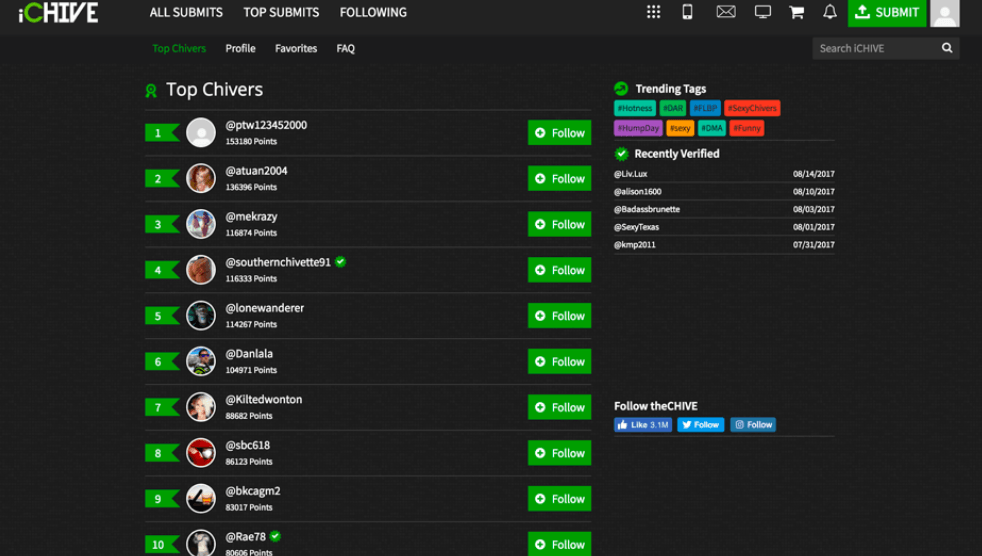
Examples by industry
Fashion and apparel ecommerce: crafting style-centric loyalty in online fashion.
The fashion and apparel ecommerce sector thrives on the allure of exclusivity and the joy of personal expression. Fashion loyalty programs are uniquely positioned to tap into these consumer sentiments. Here, loyalty isn’t just about transactions: it’s about becoming part of a fashion-forward community and enjoying the perks that come with it.
Fashion brand Lively is an example of a consumer loyalty program that makes its most loyal customers feel special. It rewards members with points on their birthday, when they refer a friend and if they follow Lively on social media.
It’s easy for members to see the perks because benefits are clearly explained across their site.
Not only is it an effective loyalty strategy for a fashion brand, but customers also see the value of joining straight away. They’ll get 100 “Lively points” just for signing up. And that translates into $10 off their next purchase.
So, it’s a customer loyalty program that offers instant gratification. It also creates a strong and lasting emotional bond with the customer early on.
The results are impressive: all this customer loyalty led to an increase in average customer lifetime value of 39%, and average spend increased by 36%.
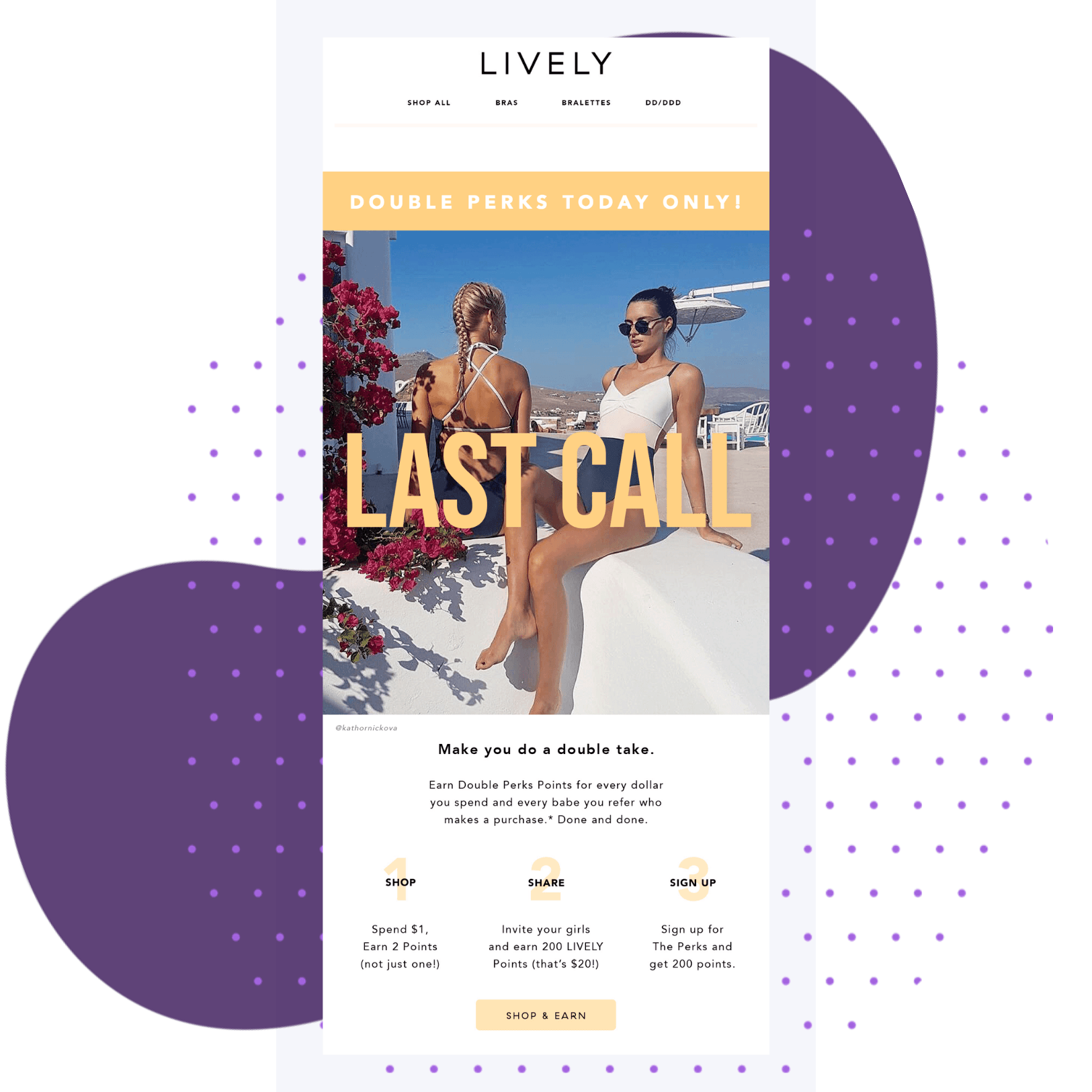
Pulse boutique
Women’s fashion store Pulse Boutique offers customers a better chance to engage with their brand by inviting them to be part of a trusted fashion community.
This customer loyalty program is called Pulse Perks . It aims to encourage customer engagement on social media. At the same time though, it also helps increase user-generated content (UGC), customer reviews and photo submissions.
UGC and reviews are vital to retail brands because research has found that at least 9 2% of people trust word-of-mouth recommendations from friends or family. Meanwhile, people are four times more likely to buy a product if a friend or family member recommends it.
Since its launch, this example of a loyalty program generated a 39% uplift in returning shoppers. It also drove a 19% growth in average order value (AOV).
These programs work because fashion is a highly visual and shareable industry. Encouraging customers to share their fashion hauls, style tips, or outfit of the day (#OOTD) posts with brand-centric hashtags can amplify a brand’s presence on social media. Brands like Zara and H&M have effectively used user-generated content to engage their community, creating a ripple effect of brand visibility and customer engagement.
The key for fashion ecommerce brands is to tailor loyalty programs that not only reward purchases but also encourage brand interaction and social sharing. This approach resonates well with fashion consumers who value both the product and the experience surrounding it.
Beauty and cosmetics brands
In the beauty and cosmetics ecommerce industry, loyalty programs play a pivotal role in enhancing customer experience and brand loyalty. This sector, characterized by its emphasis on personal care, self-expression, and frequent product launches, finds unique value in loyalty programs that offer personalized rewards and exclusive experiences.
Annmarie’s “Wild and Beautiful Collective”
The aim of Annmarie Skin Care was to develop a loyalty program where members felt part of a community that shared similar beliefs and values. So, they created the “ Wild and Beautiful Collective ” to bring their members together.
It’s so important to create a sense of community – especially in the beauty industry. Beauty shoppers are more vocal on social media, for example. They’ll share tips, recommendations and look to learn and thrive from each other.
The “Wild and Beautiful Collective” is a membership program example that nurtures this sense of inclusion through its name and mission. And Annmarie Skin Care’s approach speaks volumes. Members spend (on average) 140% more than non-members. The brand generated more than 1000 reviews too.
Meanwhile, they enjoy high levels of engagement with members, with 40% of points being redeemed within three months of being awarded.

Pacifica Beauty ’s customer loyalty offering seeks to engage customers through the whole buyer journey . It has a branded, easy-to-use loyalty page . And there’s a pop-up display that will show you how many points you can redeem in the cart. At each stage of the process, the brand aims to make it easy for the customer.
As you near the end of your buyer journey , Pacifica Beauty shows a checkout slider. This lets you claim the rewards you’ve earned towards your purchase.
Now, thanks to this example of a customer loyalty strategy, Pacifica Beauty’s members spend 130% more on average than non-members.
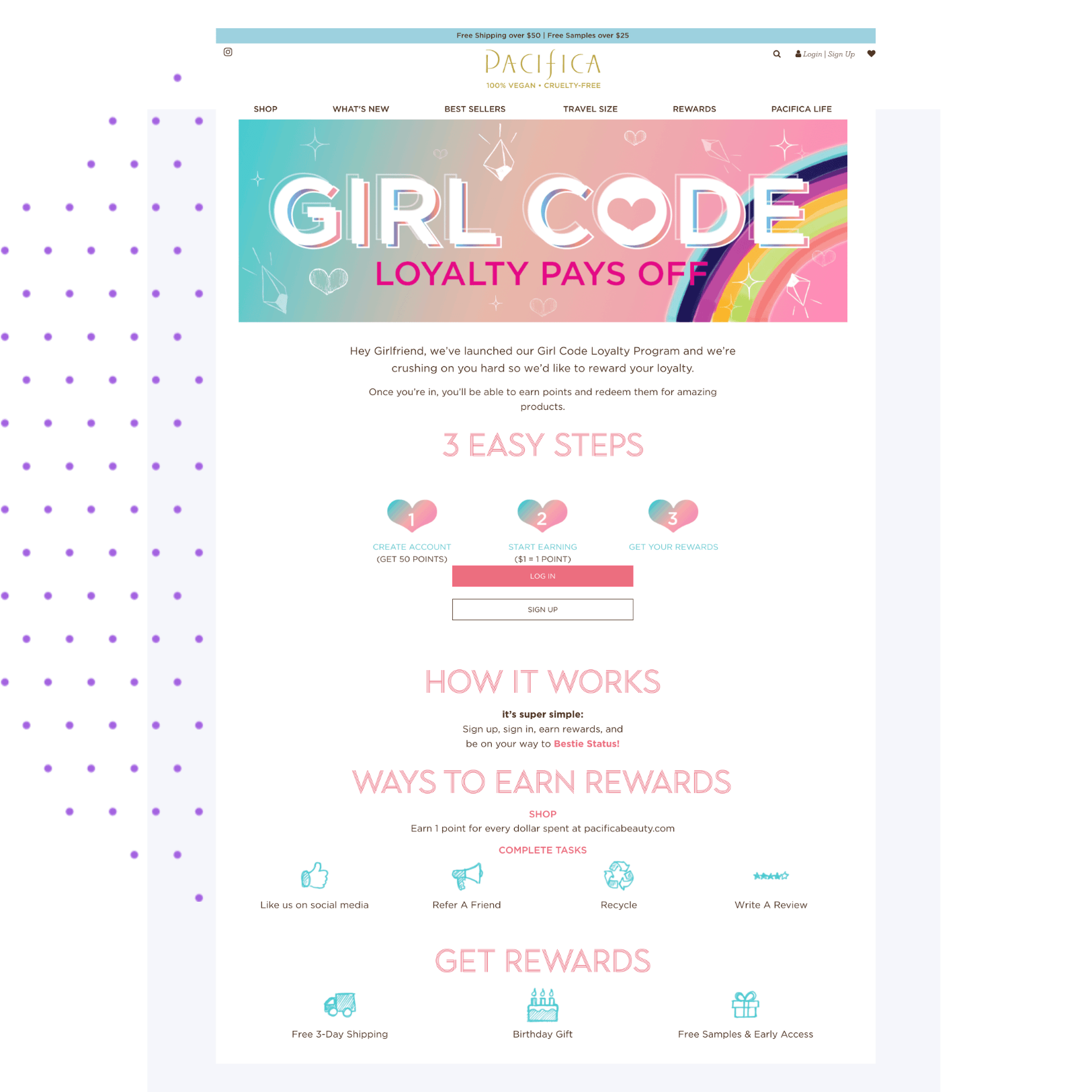
Beauty brand Mirenesse elevated their loyalty program by introducing a special paid member tier. This is known as the “Gold” tier.
In exchange for a $10 monthly membership, customers of this VIP tier get extra perks on top of the basic rewards. This includes two points for every dollar spent, access to secret sales and the chance to trial new products as part of a tester panel.
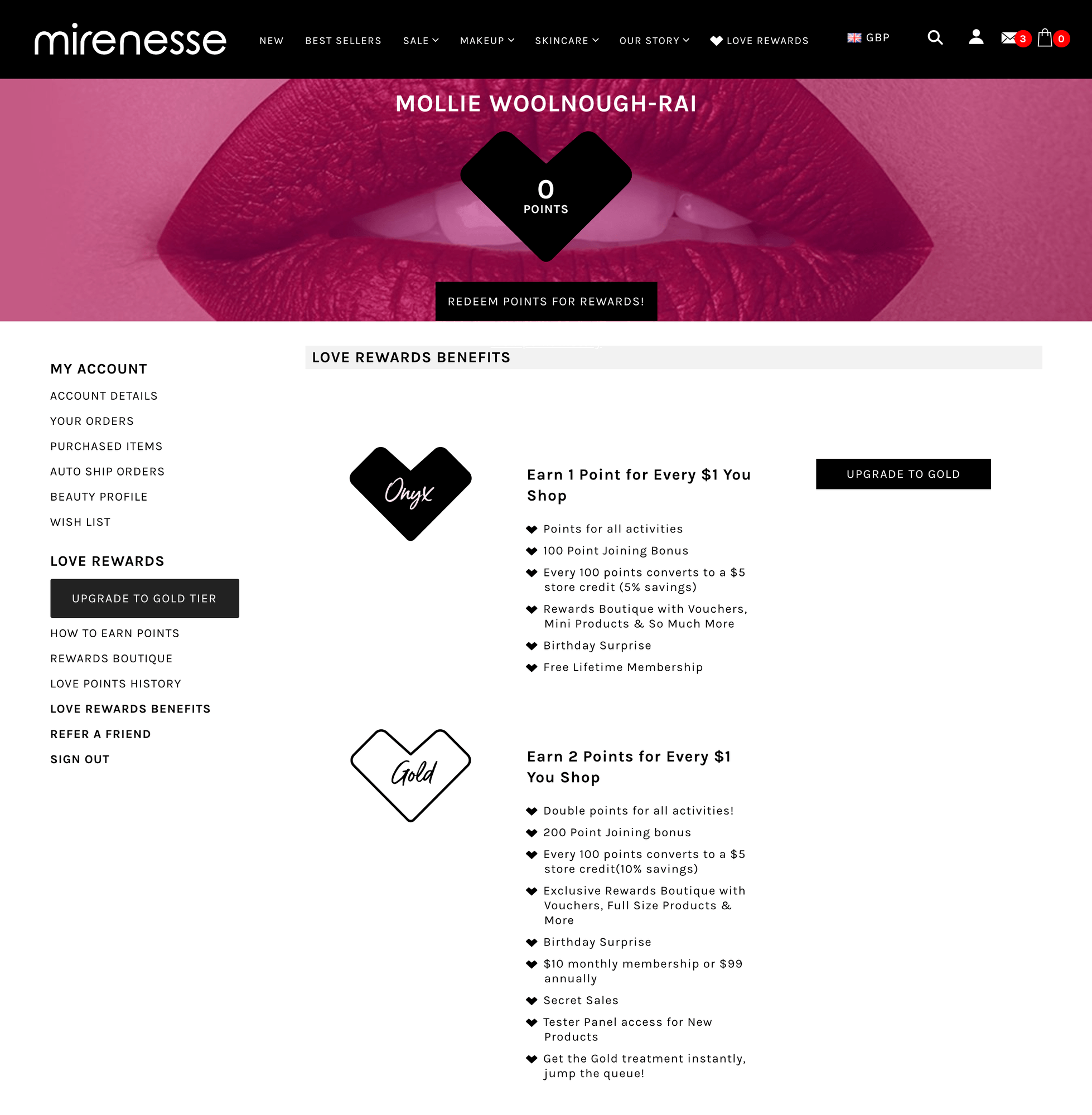
Sports and outdoor ecommerce: elevating adventures with rewarding experiences
Outdoor brands have long done more than most to connect with their customers based on shared values.
Patagonia set the standard with their “Don’t buy this jacket” PR campaign . The ad, which encouraged potential customers to buy a used Patagonia jacket rather than a new one, detailed the environmental impact in the creation of each new jacket.
A number of other big outdoor brands have incorporated this apparently-genuine, values-based customer connection into their loyalty programs.
The North Face’s “XPLR Pass”
The North Face’s XPLR Pass membership program, which offers rewards ranging from discounts to competitions and early product access, gives loyal customers 20% off their next order for completing a course on racial diversity.
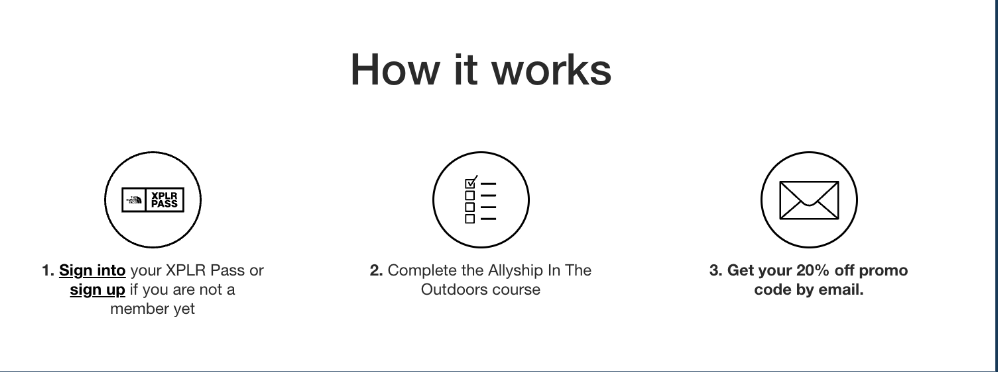
REI’s “Co-op Membership” program
REI’s Co-op Membership program , along with the more standard benefits of discounts and free delivery , builds on the connection between customer and brand by giving cashback on purchases based on business profits. They’re also invited to elect candidates to the board.
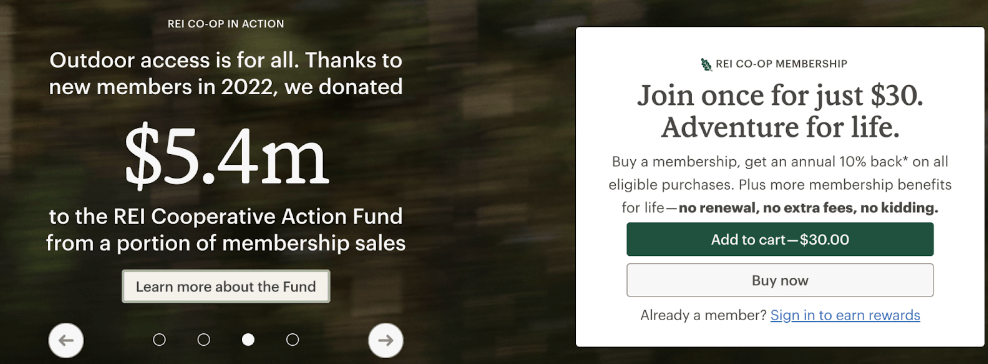
So why does it work? Because the products customers buy from these brands are used towards a hobby they care about. They’re not necessary purchases, they’re purchases that reflect these customers’ values . And brands share those values in an authentic way — through their transparency, ethical business structures and focus on sustainability.
It’s not something you can fake. And it’s harder — but not impossible — to build this kind of connection when you sell an everyday commodity.
Loyalty program branding: 4 brands that get it right
Loyalty programs succeed and fail by the attractiveness of their rewards — but how you design and brand your loyalty program can make a big difference too.
Lucy and Yak , a sustainable dungarees brand, is notable for its visually appealing integrated loyalty page. Using UGC photos of customers wearing their products and lifestyle imagery to showcase how customers can earn points, it is fun and on-brand.
Lucy and Yak describes its customer loyalty platform in their own tone of voice . You don’t just earn points, you earn “Yak points”. You don’t get “tier 1”, “tier 2” and “tier 3”, you get “Comfort Lover” “Yak Enthusiast” and “Dungaree Devotee”.
Lucy and Yak makes the most of its strong brand personality to boost its loyalty program. And that, in turn, strengthens the brand further.
Waterdrop – a “micro drinks” company – are paying careful attention to the look and feel of their loyalty program page. It means the Waterdrop Club is synonymous with the overall branding .
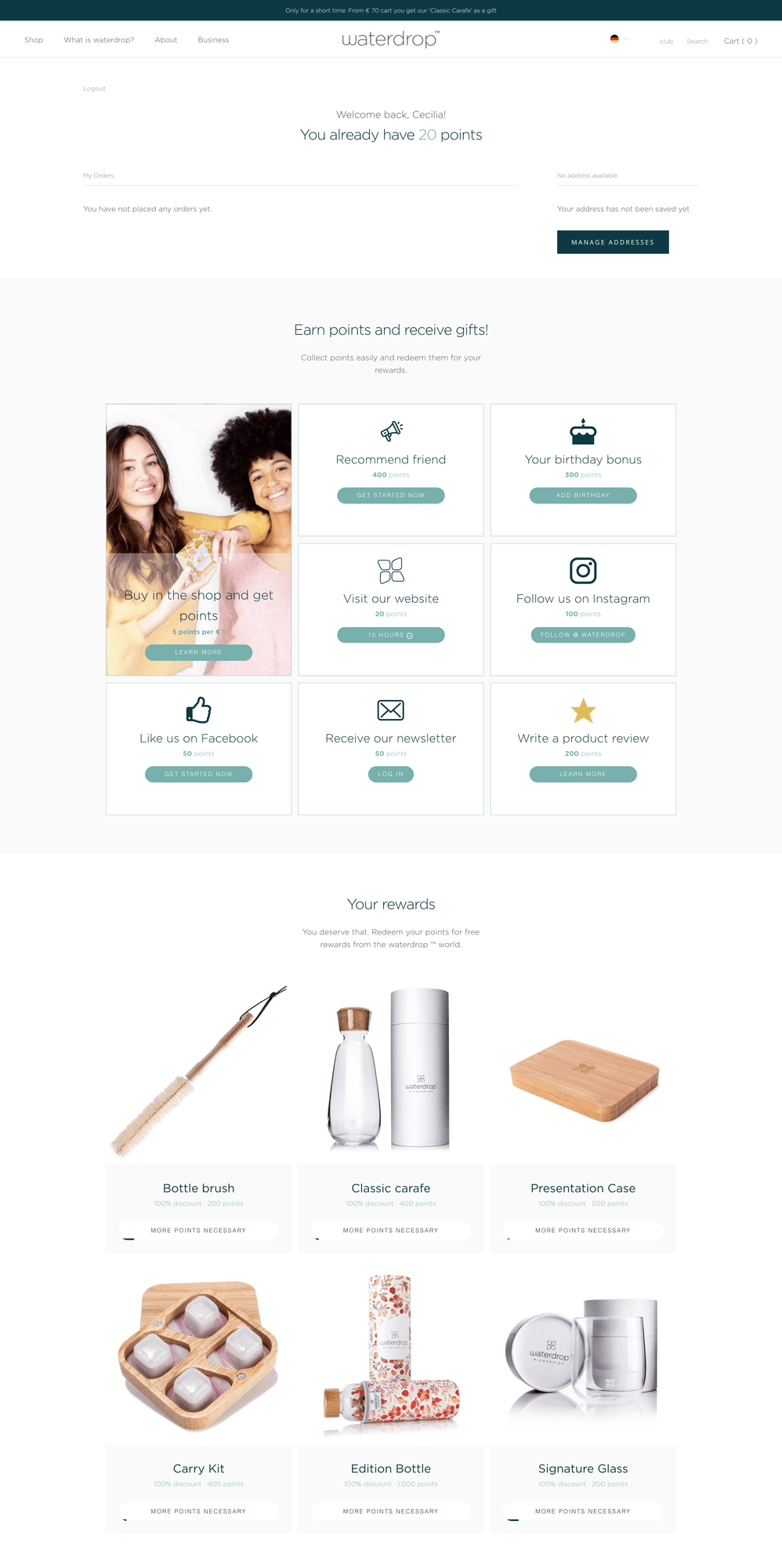
It uses fresh colors, light imagery and inclusive language.
On the page itself, everything is signposted clearly – from actions that customers must take to earn points, to information on the free gifts they can acquire.
Waterdrop’s loyalty program helpedg the brand to generate more than €58,000 from referrals . It’s one of the most effective health and wellness loyalty programs out there .
But if you’re looking for good examples of loyalty programs, sometimes the clue is in the name.
Nicce Clothing paid special attention to the name of their program and how they named their points system. “N Coin” is a simple, yet memorable term. It’s a customer loyalty program that clearly has its own brand. But Nicce Clothing also ensures it works with their overall contemporary and minimalist identity.
Eat Bobo’s
A family-run oat bar company, Eat Bobo’s got creative in naming their loyalty program example. Bobo’s Love Mitts is the name, while the points are called “Love Mitts”. Like Lucy and Yak, Eat Bobo’s loyalty program leverages and strengthens their down-to-earth, crafted-by-hand image.
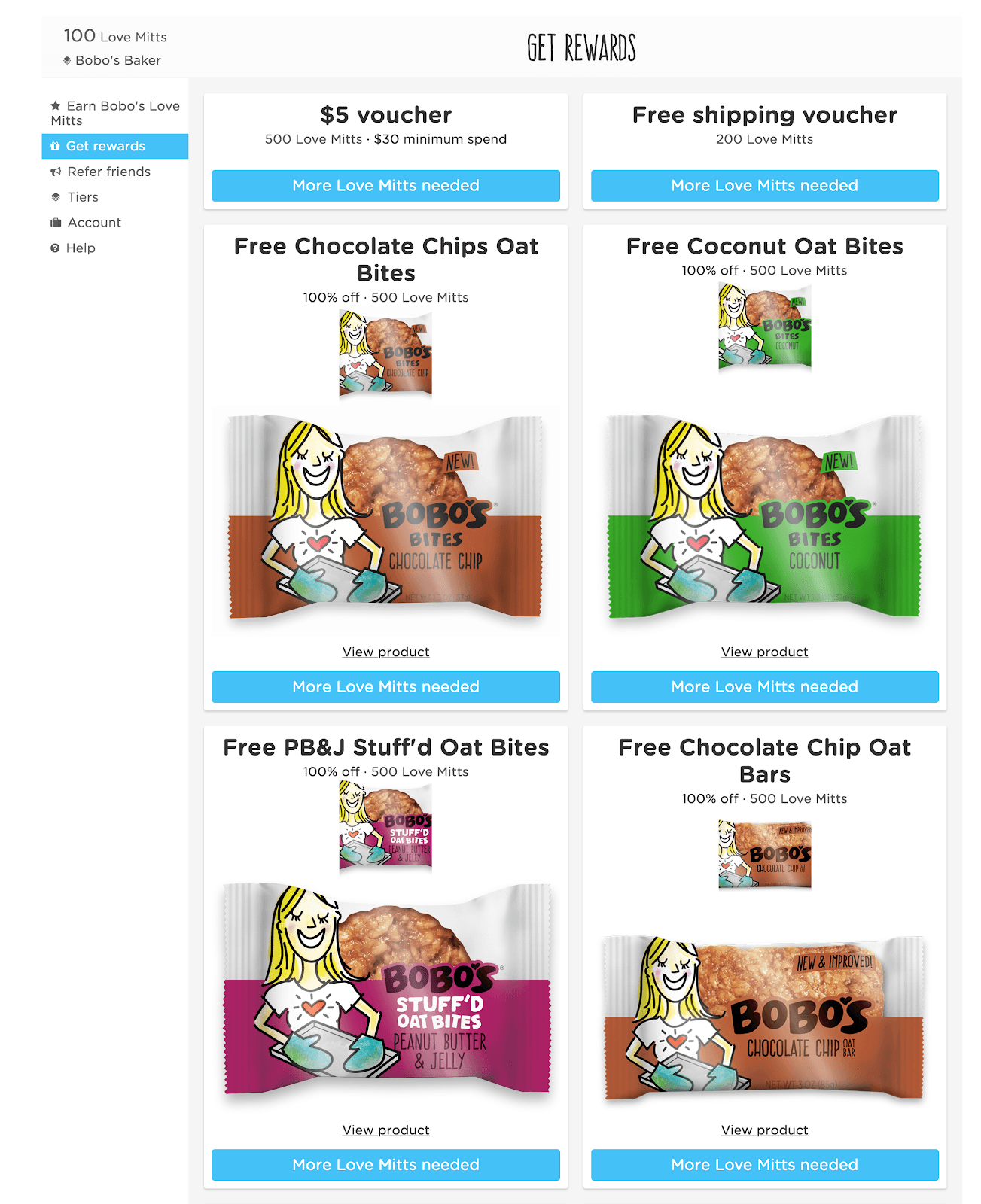
6 examples of effective loyalty program marketing
If you want people to sign up to your loyalty program, you need to tell them about it. Here are a few brands that are particularly good at marketing their loyalty program.
Email marketing
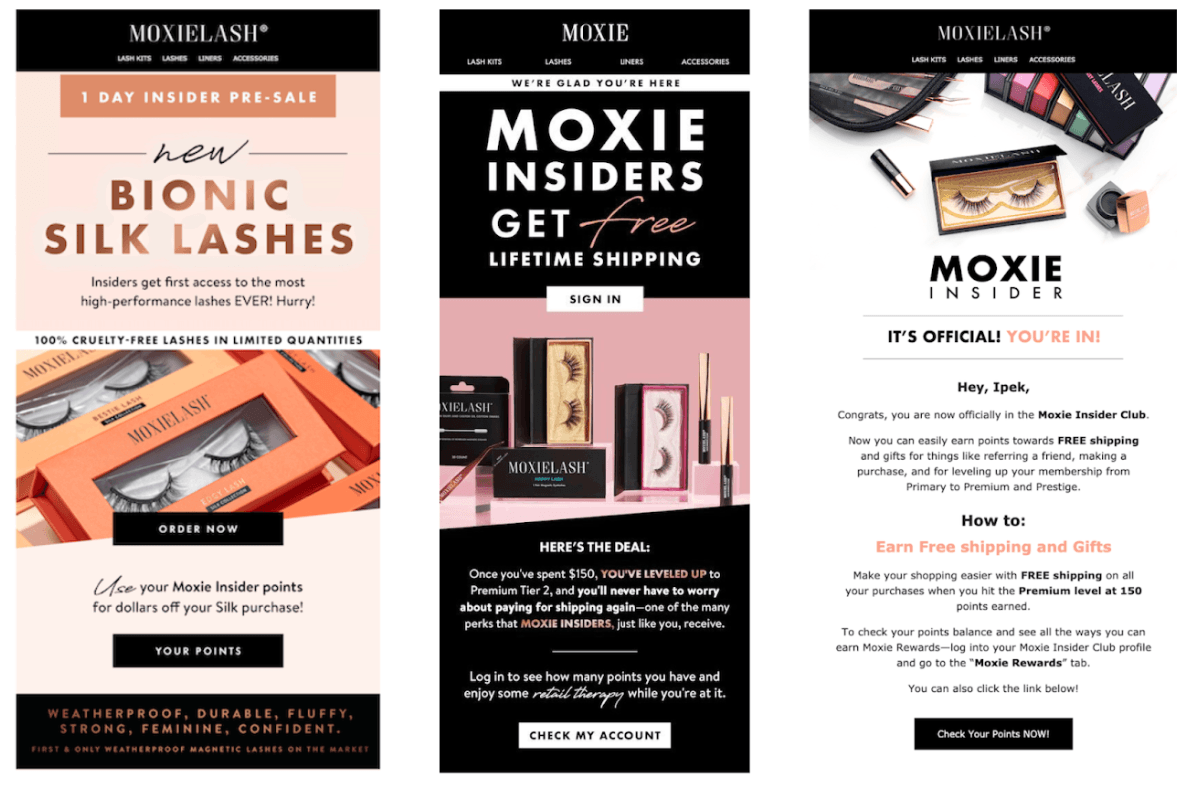
MoxieLash get their loyalty emails right. They’re visually appealing, to-the-point, and the value proposition is crystal clear.
Loyalty pages
Encourage your customers to enroll in your loyalty program by building it a standalone page.
100% PURE built a beautifully designed loyalty page to explain the benefits of the loyalty program and to encourage customers to enroll.
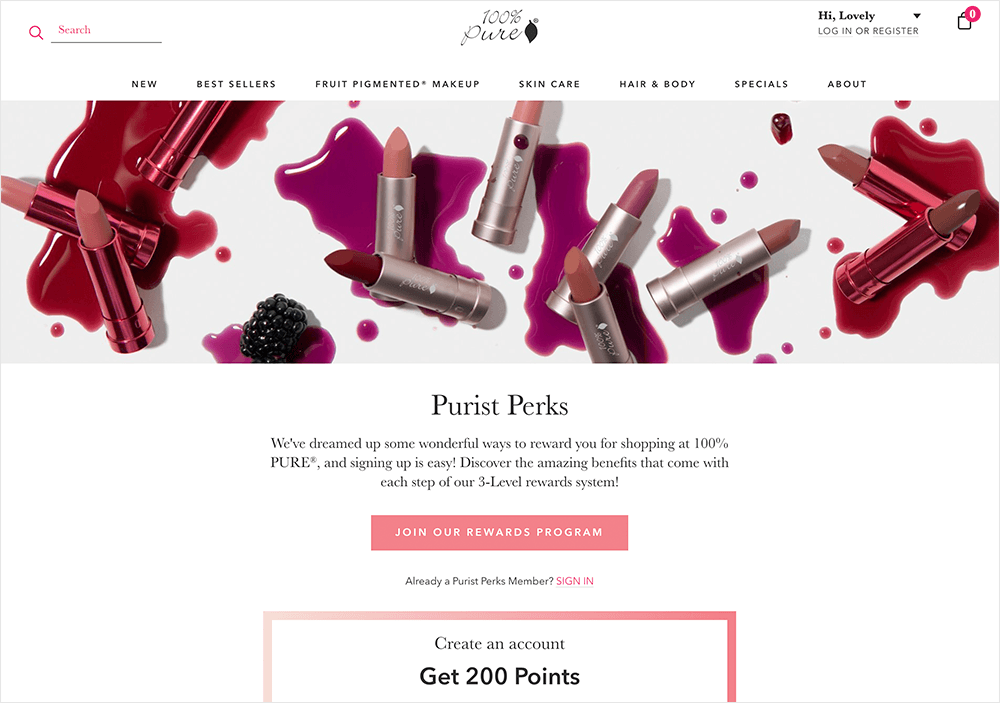
Time-limited promotions
“Short-time only” promotions encourage loyalty program sign-ups by creating a sense of scarcity. You could try “double points week”, or offering money off a product to loyalty program members for a month.
Dr. Axe has run promotions like triple point weeks, seasonal offers and higher rewards for referrals.
They also incorporate the loyalty program into all their email marketing and across their website.


Refer-a-friend
Word-of-mouth referrals are often the best way to acquire high-value customers at low cost. Building specific rewards for referrals into your loyalty program is a good way to increase its value.
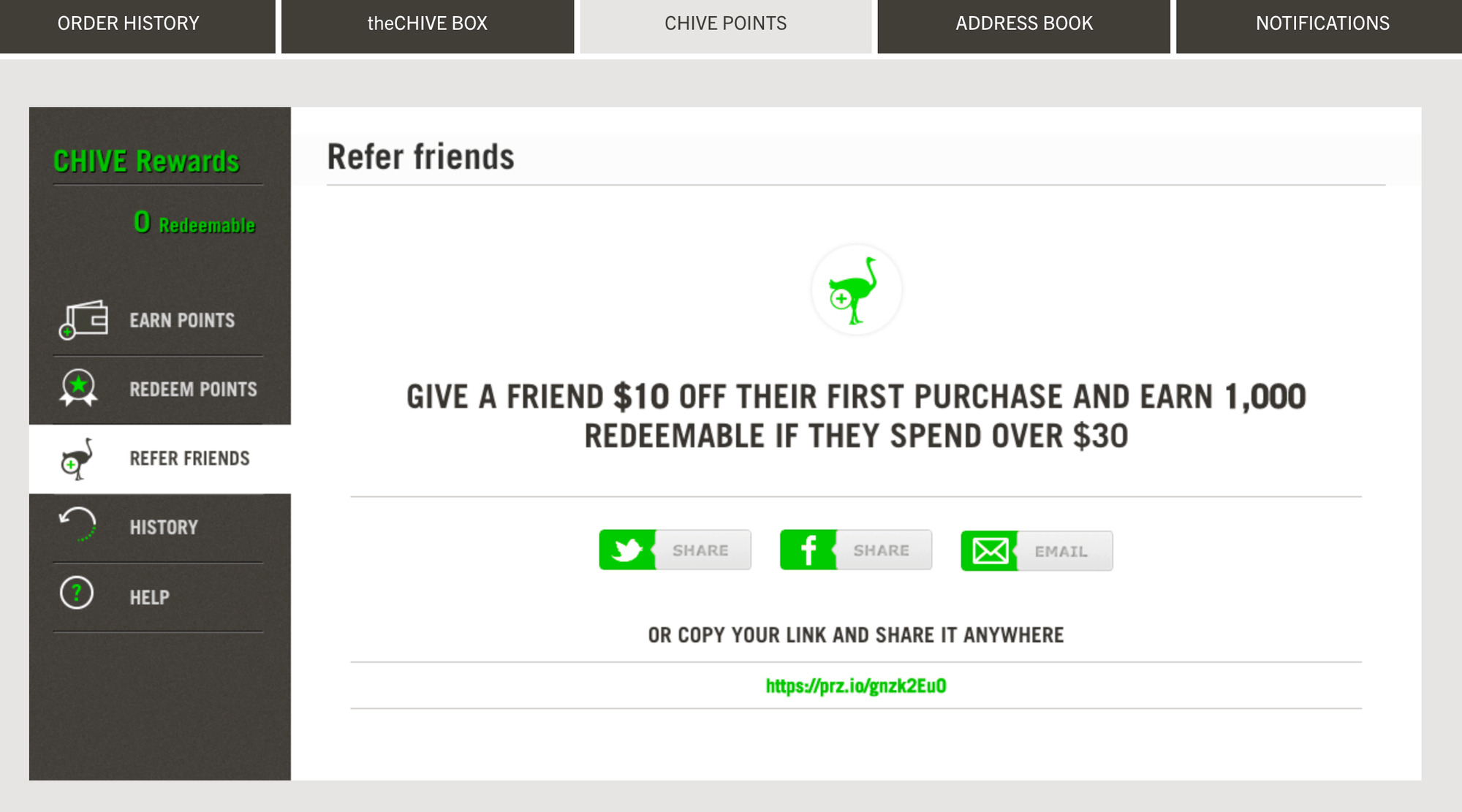
Banners and popups
Like Pulse Boutique , you can use website banners to announce the launch of your loyalty program. It’s a solid, concise way to explain the benefits and include a strong call-to-action.

Contests and leaderboards
An often-effective way to scale up your loyalty program is to introduce a competitive element — for example, by creating a kind of “leaderboard” of referrals, and rewarding those customers who are most prolific.
And by having an effective loyalty program marketing plan for those newly referred customers, this can turn into a virtuous cycle.
Ready to use loyalty marketing to your advantage?
These examples show us just how powerful loyalty programs can be, how great brands are making the most out of theirs, and how you can use your understanding of your own audience to design your own successful loyalty program.
But for many smaller ecommerce businesses, the biggest challenge is implementation. How do you set up, optimize and analyze your loyalty program without significant investment of both time and money?
With this, LoyaltyLion can help. When you’re ready to get started, book a demo .
About the author
Mollie woolnough-rai.
Share this article
Join our virtual retention summit
Discover the secrets to building a customer-centric Shopify store.
Related Articles
Demystifying loyalty points: a guide to calculating loyalty point value,....
Learn how points work, discover best practices for calculating their value, and get insider tips on setting rewards that drive engagement and customer loyalty.
The 5 best beauty loyalty programs and why they’re so effective (2024)
Discover the best beauty loyalty programs that drive customer retention and repeat purchases. Learn what makes these programs effective and how to implement key features into your own loyalty program.
Unlocking the Potential of TikTok Shop for Brands: A Path to Customer Re...
Find out how you can use the power of TikTok Shop to boost customer retention and loyalty.
Grow your business with LoyaltyLion
The Success of Starbucks App: A Case Study
Starbucks has the most regularly used loyalty rewards app among major restaurant chains. But what keeps users coming back for more? This case study will look at the design of the app, its features, and the bold moves that the coffee chain has made to make the app a “must have” for consumers.
Updated May 12, 2023
A recent study found that Starbucks has the most regularly used loyalty rewards app (48%) among a list of major restaurant chains. Why is the app so popular? What is it that keeps users coming back for more? The answer is digital engagement . From ordering and paying ahead of time to creating your own Spotify playlist, the Starbucks app provides a user experience that is both inviting and innovative, much like the coffee chain itself. That digital engagement has paid tremendous dividends for the company. At a JPMorgan forum in March, Starbucks CFO Scott Maw said almost all of the company’s same-store sales growth has come from customers that have digital relationships with the company and those that are in the Starbucks Rewards program. This case study will discuss four main reasons why the Starbucks app is a “must have, must use” app for customers:
- Easy Navigation
- Personalization
- Geo-location
- Mobile pay and ordering
- Integration with other platforms and services
1. Easy Navigation
The app's layout is simple, yet elegant, making the app appealing to the user. However, the platform's navigation is what makes it stand out. Navigating through the Starbucks app is quick and easy, making it conventient for users to place an order.
Five menu options at the bottom of the app page give the user access to the major functions: Home, Scan, Order, Gift, and Offers. Having the menu at the bottom of the screen makes it easier for users to access the most important pages on the screen because it's well within reach of a user's thumb.
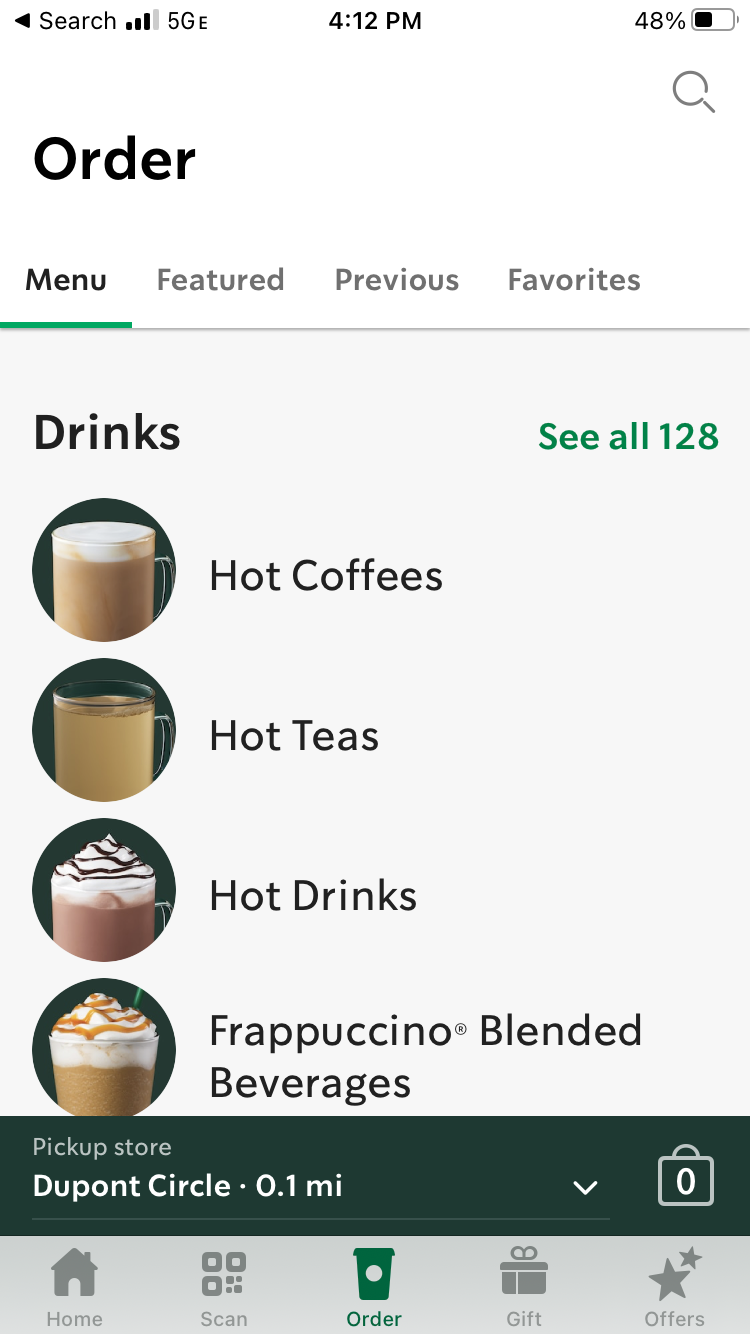
Additionally, the Starbucks app is exceptionally innovative because it provides a similar experience to visiting the store . Many of us have stood in line at Starbucks thinking, “I should get a gift card for (insert person/occasion).” The Gift menu brings up a variety of gift cards for nearly every occasion, and even suggests cards for upcoming holidays. Starbucks added the convenience functionality despite the risk of placing too many “bells and whistles” in the app. Chief Digital Officer Adam Brotman acknowledged that the company didn’t “ want the app to become too much of a Swiss Army knife .”
However, the innovative features have been well received and have not overwhelmed users. The Starbucks app provides its users with a personalized experience.
2. Personalization
Starbucks added personalization elements allowing the app to recall your favorite order, suggest what food items might pair well with that order, and where you’d like to pick it up. Again, this simplifies the user experience and makes it especially easy to place an order. It keeps track of what you've ordered in the past and your favorite drinks to ensure that it's easy for users to place their order during their morning commute.
3. Geo-Location
There are Starbucks everywhere, so it's important for users to be able to select which one they wish to visit when they place an order. The app uses geo-location to show where each storefront is located and how close a user is to each one.
Using the geo-location feature, a user can see where the closest Starbucks locations are, the menu at each location, and even place an order that can be ready upon arrival.
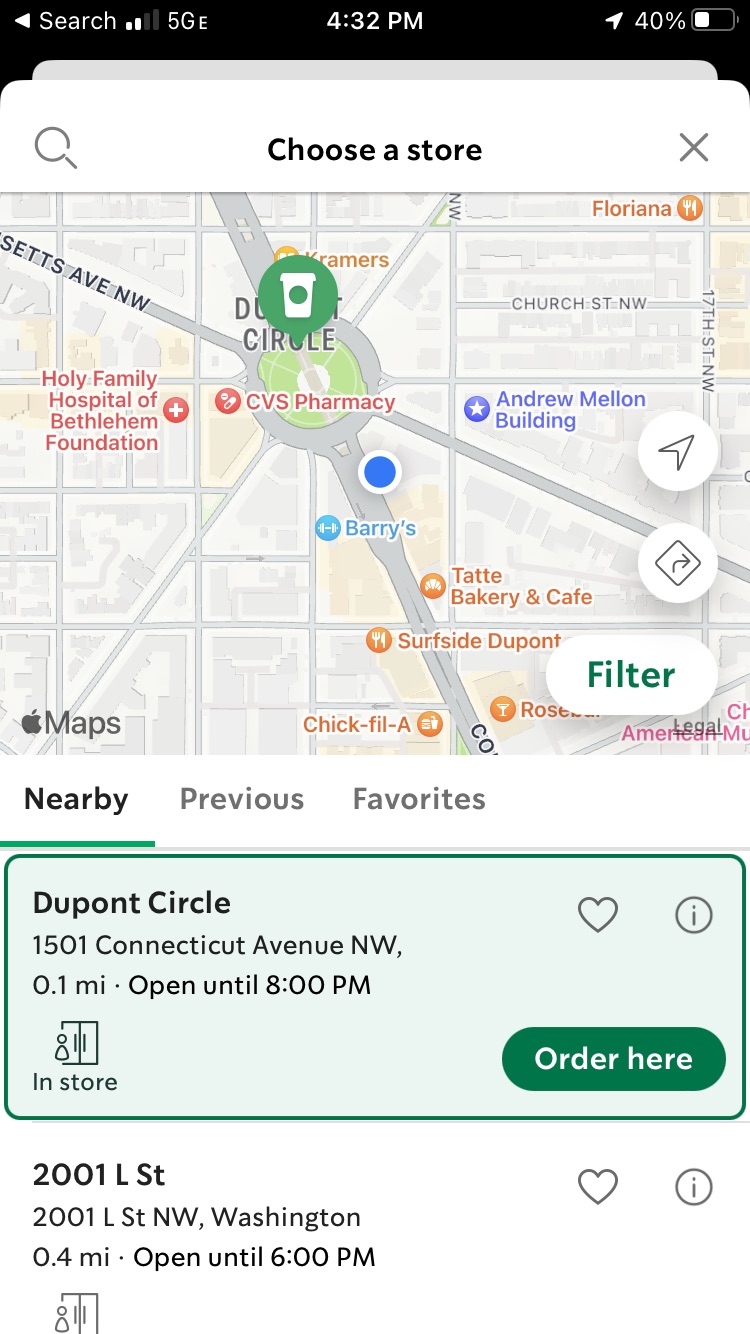
If you often order from a specific location, the app will automatically select that location, limiting the number of clicks a user has to make to place an order.
4. The Starbucks Rewards Loyalty Rewards Program Leads the Competition
The Starbucks Rewards program is a prime example of how to get customers to utilize a mobile app. Simply put, the more you spend at Starbucks, the more rewards points (or “stars”) you earn. Not only is this great for users on the app, but it also helps foster brand loyalty. With the promise of rewards, users are more likely to order from Starbucks in the future.
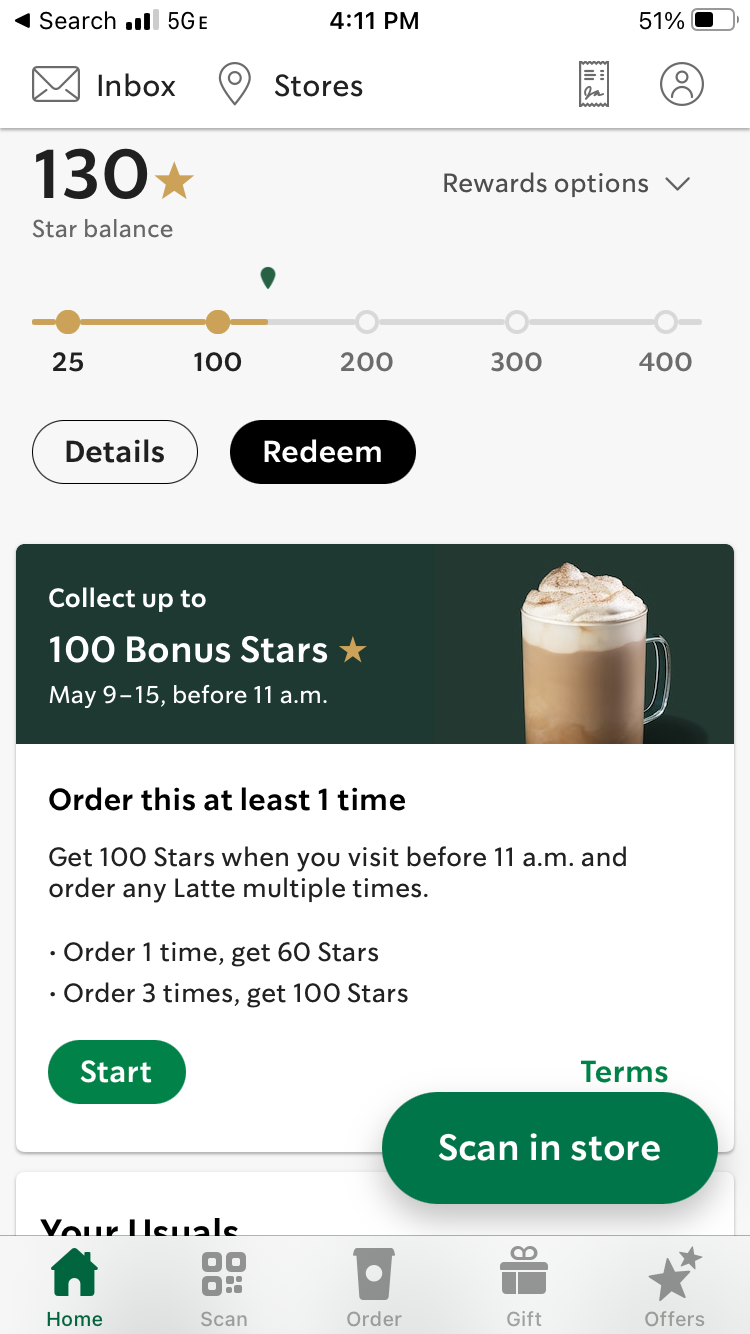
The rewards program gives a number of benefits for app users. In addition to earning two stars for every dollar spent, rewards members get other benefits like free in-store refills, special member offers/events, and the ability to pay by phone and order ahead.
The rewards program also offers plenty of customization for users, including a free beverage on the user’s birthday and personalized suggestions based upon past orders. In return, Starbucks solidifies an instant digital relationship with the 14.2 million active U.S. rewards program members. The loyalty program has seen hefty growth , with an 11% growth in users in Q2 2018. And Starbucks rewards program members in certain places actually spend more, representing 39% of the entire chain’s sales . However, Starbucks recognizes that not all customers want to join the rewards program. Starbucks is planning to ramp up digital interactions by offering mobile order and pay options to all customers—not just rewards members. The company also will take advantage of Wi-Fi sign-ins at various stores to help drive mobile order and pay options. The Starbucks rewards program encourages users to utilize the app to track purchases, as well as the stars earned. To facilitate their usage, stars have a limited shelf life—one year for basic (or “Green”) level rewards customers, and six months for upper-tier (or “Gold) members. The app provides reminders about stars that are expiring, as well as the number of stars needed to maintain Gold status. Gold members also get special double-star days when they earn four stars per $1 spent.
5. Starbucks’ Mobile App Makes Online Ordering and Paying Easy
Since launching the initiatives in 2015, Starbucks has become the standard bearer when it comes to mobile ordering and payments. Mobile Order and Pay is a feature that let customers order via Starbucks’ app and skip the line. At first, the growth of Mobile Order and Pay caused some congestion issues inside stores for customers while picking up their coffee and/or food. As one customer stated, “Why should I order ahead if I just have to stand in line to retrieve my order?”
Starbucks responded by adding dedicated stations for mobile order-ahead customers, distinct from existing in-store registers, and giving baristas new tablets. The mobile ordering system acts as a digital marketing tool, allowing customers to see new items ahead of time. Coupled with notifications from the app or email blasts, Starbucks creates interest in new menu items long before the customer sets foot in the store. Often, these digital tools create a sense of urgency for customers to sample the latest offerings. Starbucks also enabled orders via Amazon's Alexa, and the feature has also been integrated into Ford vehicles. The coffee chain also expanded its My Starbucks barista, a feature integrated into the Starbucks app, which allows customers to order via voice command or messaging. The goal was to boost speed and convenience. In-store payments are also encouraged through the app, which utilizes a Starbucks gift card to process the payments. This creates seamless transactions, as the gift card can be automatically or manually reloaded using a credit card, Apple Pay or Google Pay, or even with the balance from another gift card. The app screen can be scanned at the register to process the payment. For iOS users, the app integrates with the Apple Watch, producing a bar code that also can be scanned for those on the go.
By offering a wide variety of functionalities, Starbucks’ Mobile Order and Pay allows users to order and pay in the way that is most convenient for them – which encourages greater sales.
Starbucks’ App Exemplifies Loyalty App Success
The Starbucks app is the center of the company’s digital ecosystem, bringing together loyalty, mobile payment, and content partnerships, all seamlessly integrated into one convenient application. Restaurants can follow Starbucks’ example to create a successful restaurant loyalty rewards app.
David 'DJ' Oragui
Founder & Lead Growth Engineer at Grow Hack Scale, Balanced Narrative and Balanced Life Academy Group., Grow Hack Scale
Need help selecting a company?
Our team will connect you with a verified company.
Recommended Development articles
Custom software dev must-haves for the development phase, how does release candidate testing work, 5 unseen problems of using an ai to generate content and how to prevent them, how to become a technical developer, hire a top development company.
Blockchain Companies
App Modernization Companies
DOTNET Companies
eCommerce Companies
Java Companies
Software Testing Companies
Web Developers Companies
Artificial Intelligence Companies

10 best customer loyalty programs and their case studies
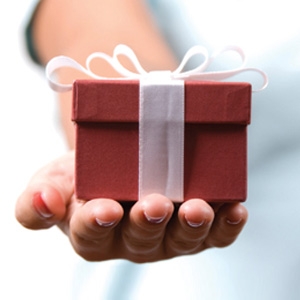
- 6X more expensive to win a new customer than retain as existing one ( Parature )
- 5% increase in customer retention can lead to a 25-100% increase in profit for your company. ( Harvard Business Review )
- 68% of millennials wou l dn’t be loyal to a brand that doesn’t have a good loyalty program. ( Loyalty Report )

Rob Petersen
Leave a reply cancel reply.
Your email address will not be published. Required fields are marked *
Save my name, email, and website in this browser for the next time I comment.
Cookie consent
We use cookies to ensure our website works properly and to analyze our traffic to enhance your experience. By default, we only use strictly necessary cookies. To learn more about how we use cookies and respect your choices, please visit our privacy statement page.
Mobile App Features that Drive Loyalty (with 3 Case Studies)
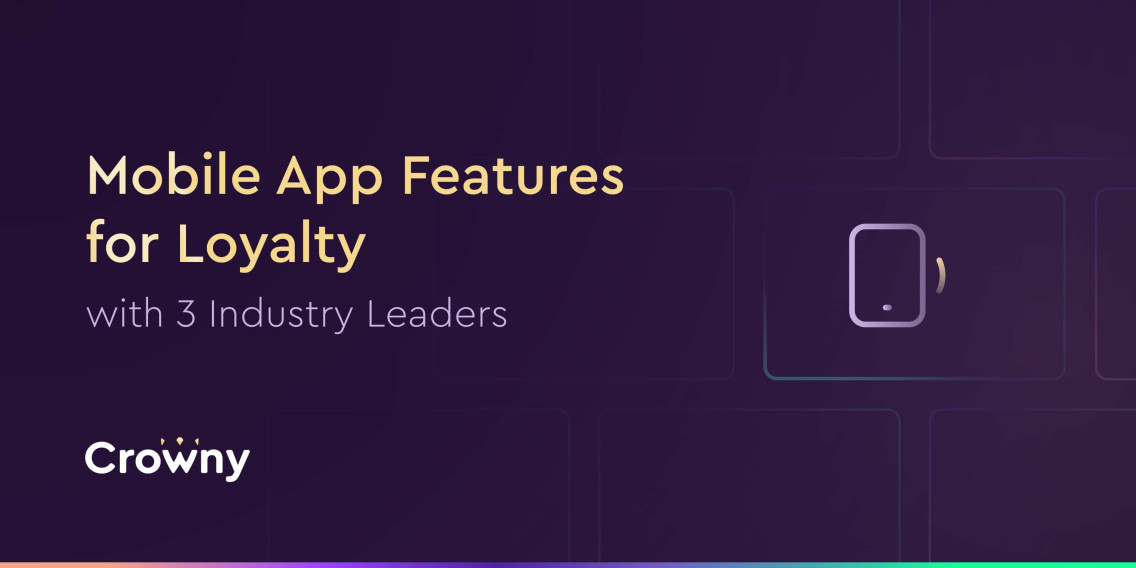
What mobile app features foster loyalty, and how do industry leaders use them? Crowny empowers brands of any size to tap into mobile loyalty, find out how.
Table of contents
- ☑️ Why a mobile app fosters loyalty the best
- ☑️ What app features improve brand loyalty
- ☑️ Industry-leading examples
- ☑️ 8 advantages for brands with a mobile loyalty program
- ☑️ Crowny’s value-add
- ☑️ Sign up now
Why a mobile app fosters loyalty the best
A mobile app can be the ultimate tool for many brands to foster loyalty. By being readily accessible on customers' smartphones, it ensures constant opportunities for communication and immediate engagement. Mobile apps provide industry-leading brands with invaluable touchpoints in the customer journey to nurture loyalty. With the opportunity for direct and real-time communication through push notifications and in-app messaging, brands with great mobile app engagement are enabled to always deliver their message. As a result of this high-level engagement, they are in the position to build stronger customer relationships that result in overall increased engagement with their online community. It’s one of the most effective best practices of relationship marketing . Not convinced? Check out these statistics that back our statements:
☑️ By 2025, mobile commerce is projected to exceed $728 billion - eMarketer
☑️ Mobile app usage has increased by 34% from 2018 to 2022, surpassing mobile browser usage, which decreased by 8% - eMarketer
☑️ In the US, annual in-app purchase spending is expected to surpass $50 billion by 2025, up from $30.4 billion in 2020 - Insider Intelligence
☑️ Compared to mobile websites, apps have 3x higher conversion rates - Criteo
☑️ Apps account for 70% or more of mobile sales for retailers with both apps and websites - Criteo
.jpeg)
What app features improve brand loyalty
There are several app features to be considered when looking for the perfect ones to improve brand loyalty. By harnessing the power of mobile app features like these, brands can effectively cultivate long-lasting customer loyalty, drive business growth, and gain a competitive edge in the market. Brands can leverage the following app features:
☑️ Personalized user profiles
☑️ Seamless integration with existing loyalty programs
☑️ Push notifications and communication
☑️ Real-time analytics and reporting
☑️ Enhanced security measures and fraud prevention
☑️ Rewards and point systems
Personalized user profiles Gather valuable customer data to provide tailored experiences and rewards, catering to individual preferences.
Seamless integration with existing loyalty programs Streamline the customer experience by integrating the app with existing loyalty programs, ensuring a unified and consistent approach across platforms.
Push notifications and communication Deliver timely updates, promotions, and personalized messages through push notifications, fostering a stronger connection and enhancing customer engagement.
Real-time analytics and reporting Gain valuable insights through real-time data analysis, enabling data-driven decision-making to improve loyalty initiatives.
Enhanced security measures and fraud prevention Instil trust and confidence in customers by implementing robust security measures, safeguarding their information and reinforcing loyalty.
Rewards and point systems Incentivize customer engagement through a digital rewards system, creating a sense of loyalty and satisfaction. Crowny offers the unique interact-to-earn mechanism.
‘’59% of consumers are more likely to join a loyalty or rewards program offered by a brand if it is tied to a mobile app. Plus, 82% of consumers are more likely to shop at stores that have loyalty programs versus those that don’t. So a loyalty program in an app is a win-win’’ - Technology Advice
Industry-leading examples
Several industry-leading companies have successfully leveraged apps to drive loyalty, setting an example for brands.
Nike has effectively used its NikePlus app to drive customer loyalty in the sportswear industry. The app offers personalized training plans, exclusive product releases, and rewards for achieving fitness goals. Through features like in-app challenges and social sharing, Nike has built a community of loyal followers and engaged customers . The app's seamless integration with Nike's e-commerce platform allows for easy purchasing, further enhancing the customer experience. Nike's successful NikePlus app has resulted in increased brand loyalty, customer retention, and a stronger connection with its target audience.
Sephora's Beauty Insider app offers a comprehensive loyalty program tailored to beauty enthusiasts. The app provides personalized product recommendations, exclusive discounts, and a virtual beauty community. By leveraging data-driven personalization and gamification elements, Sephora has successfully fostered a sense of community and loyalty among customers, driving repeat purchases and brand advocacy.
Through its Prime membership program and mobile app, Amazon has drastically improved customer loyalty. Prime members enjoy free shipping, exclusive discounts, and access to streaming services. The app offers personalized recommendations, seamless ordering, and a seamless cross-platform experience. Amazon's app-driven loyalty strategy has resulted in a large and dedicated customer base, driving customer retention and increased sales.
.jpeg)
8 advantages for brands with a mobile loyalty program
Brands with a mobile loyalty program enjoy numerous advantages that contribute to their success. By implementing a mobile loyalty program, brands can enjoy these advantages, fostering customer loyalty, gaining valuable insights, and driving business growth in a competitive market. Here are key benefits to consider:
☑️ Increased engagement
☑️ Enhanced loyalty
☑️ Valuable data
☑️ Improved insights
☑️ Differentiation
☑️ Cost-effective
☑️ Enhanced experience
☑️ Word-of-mouth
Increased engagement A mobile loyalty program enables brands to engage customers more effectively, fostering a deeper connection and encouraging repeat purchases.
Enhanced loyalty By offering exclusive rewards, personalized experiences, and targeted promotions, brands can cultivate loyalty among their customer base, resulting in higher retention rates.
Valuable data Mobile loyalty programs provide brands with access to valuable customer data, enabling them to understand preferences, behaviors, and trends, and make informed business decisions.
Improved insights With comprehensive analytics and reporting tools, brands can gain actionable insights into customer behavior, allowing them to refine marketing strategies and optimize their loyalty program offerings.
Differentiation A mobile loyalty program sets brands apart from competitors, offering a unique value proposition that can attract and retain customers, fostering a sense of brand loyalty.
Cost-effective Leveraging a mobile loyalty program allows brands to target their marketing efforts more precisely, reducing marketing costs and maximizing return on investment.
Enhanced experience Mobile loyalty programs provide convenience and ease of use for customers, allowing them to easily track rewards, receive personalized offers, and enjoy a seamless mobile experience to boost their loyalty loop performance.
Word-of-mouth Satisfied customers participating in a mobile loyalty program are more likely to recommend the brand to others, resulting in positive word-of-mouth promotion and increased customer acquisition.
Crowny’s value-add
In today's competitive market, the need for effective mobile loyalty solutions to foster customer loyalty and drive growth is increasing. Besides being able to provide many of the features mentioned earlier, Crowny adds value to the current offering within the loyalty industry with the following mobile app features:
.jpeg)
Multi-brand app
By offering a multi-brand app, consumers do not have to download multiple apps to join a diversity of programs. It enables brands to bundle their pulling power and lowers the barrier for consumers to join loyalty programs. This principle provides users, and therefore the brand communities, with a convenient user experience. Brands can collaborate and benefit from increased exposure, fostering a sense of community and loyalty among users with community marketing .
In-app wallet
Provide an in-app wallet that unlocks untapped loyalty mechanisms, such as earnings boosters for staking crypto and spending blockchain-based loyalty points . These features encourage active user engagement and loyalty from customers.
… customers would do better than redeem the (loyalty) points conveniently via a mobile app, rather they access multiple loyalty rewards programs on a single app like a digital wallet, reducing the lag time even further, and enhancing the customer experience - Deloitte
Omnichannel incentives
Utilize omnichannel incentives, including offline marketing channels with QR codes and geofencing, as well as social media integrations with sharing incentives and user-generated content promotions. Gather opt-in interest data to deliver personalized and relevant content, nurturing stronger connections with customers. Integration with e-commerce platforms enhances conversion incentives, driving sales and loyalty.
Opt-in and zero-party data
Prioritize privacy and trust by collecting zero-party data, respecting user preferences, and preventing intrusive experiences. Offer an in-app browser for a seamless experience with any brand, providing anonymous full-journey tracking for valuable insights into customer behavior for the best app marketing .
Sign up now
With these powerful mobile loyalty solutions, businesses can unlock the full potential of their loyalty programs, fostering customer engagement, retention, and long-term success. Crowny enables brands of any size to revolutionize their loyalty strategy and gain a competitive edge in the market.
Get early access to a demo now.
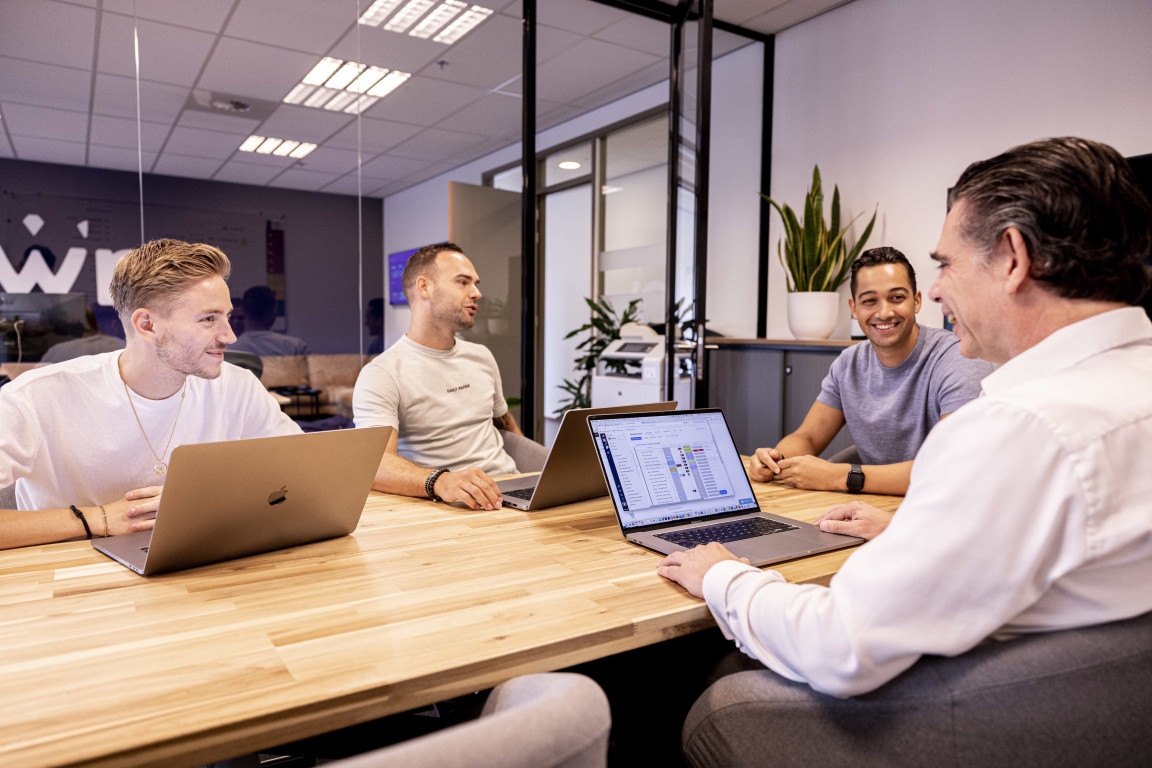
A future-ready app for world-class travel
In a world where we use our phones for almost everything, travel plans often start from the palms of our hands.
5-MINUTE READ
Call for change
Making room for mobile.
In this mobile-first era, IHG Hotels & Resorts—with 17 diverse brands and more than 6,000 hotels around the world—knew an elevated app experience was the best way to connect with and inspire loyalty from both current and next-gen travelers.
IHG’s app is its primary digital interface for interacting with and taking care of guests—and where the hotel-guest relationship often starts. For this reason, IHG needed a refreshed mobile experience to compete with the expectations set by today’s tech-first world. Additionally, IHG needed to build this new mobile experience around two priority user groups:
- Loyalty members: The IHG app is central to the new IHG One Rewards loyalty program, and members are the largest group of app users. But just like travel, the nature of loyalty has changed. IHG One Rewards is rooted in choice, flexibility, and rich rewards —and the app needed to support that.
- Hotel owners: Owned digital channels drive revenue from bookings at the lowest cost and in the most loyalty-building way—compared to third-party travel sites that take a commission and control the experience. Because of this, app innovation is a critical point of focus as owners seek to expand revenue and create sustainable growth.
As travel started to pick up in 2021, there was an urgency to get to market quickly with both the new loyalty experience and the redesigned app, and it was a massive undertaking. IHG couldn’t just reskin its current app—outdated infrastructure would produce exponential tech debt and complexity down the road. Plus, the new app needed to work with both iOS and Android, be translated into 18 languages and work across IHG’s 17 global brands and 6,000+ hotels.
IHG Wins 3 Webby Awards
IHG One Rewards mobile app won 3 categories at annual Webby Awards 2024, including People's Choice Webby Award for Best User Experience and People's Choice and Judge's Selection for Best Travel App.
When tech meets human ingenuity
Shared delivery, expert support.
IHG tapped long-time partner Accenture to help, and the team worked side-by-side to envision and deliver a new app. With access to Accenture’s insights and intelligence around emerging trends and market demands, IHG was able to dream up new ideas and broaden the horizons of possibility.
A foundational component of the partnership was the flexible delivery model, or digital “factory”—a streamlined framework for creating and delivering digital products. The factory makes previously complicated development and delivery processes predictable, repeatable and reliable at scale, across IHG’s global properties. It allows the hotel group to bring new, innovative app features and experiences—like additional payment methods (WeChat Pay in China, for example) or digital check-in—to life faster.
The agility of scalable production allows IHG to ramp the factory up or down depending on business cycles or other strategic priorities, to launch multiple upgrades at the same time and to tap key specialized talent when needed. To that end, the model provides IHG with the back-end capabilities and a dedicated delivery team to create state-of-the-art app architecture and analytics. IHG is no longer limited to small groups of highly specialized resources—more people understand how to build and support this important digital asset, reducing risk and maximizing efficiency.
The new app was launched with an extensive beta process to ensure there was no impact to booking flow and functionality, and to gather valuable feedback before the full launch. The team released the app to an increasing pool of testers, starting with 12 users close to the program and eventually releasing to thousands of IHG employees and hotel owners, key partners and corporate customers globally. This process improved reliability and allowed the team to quickly address rare error combinations well before the actual launch.
Finally, the app was launched in phases, which allowed the team to pause and learn from feedback. By late May 2022, IHG fully launched the new IHG One Rewards App at its Americas Owners Conference In Las Vegas.
A new kind of app for a new kind of traveler
With traveler behaviors and expectations changing rapidly, IHG knew they needed to change with them. The new IHG One Rewards app offers more flexibility and customization for guests on the go.

A valuable difference
Making modern travel exceptional.
The new app is sleek and seamless, providing an end-to-end personalized experience for booking, check-in, IHG One Rewards Loyalty Program benefit management and communication across all 17 brands. It also supports expanded property attributes and pricing offerings, with increased merchandising opportunities for hotels. Leveraging the digital factory, IHG improved the experience for customers with features like personalized home screens, sticky navigation and “add to wallet” functionality for reservations.
The app is the most efficient place for IHG One Rewards members to manage stays and track progress toward the newly launched Milestone Rewards—a program full of perks based on extensive research into what guests really want. Inside the app, travelers can find an account dashboard to track points and milestones, a chat-based digital concierge and the ability to add the IHG One Rewards card to their Apple or Google wallet, to name a few attributes.
Already, the app is seeing exceptional results—a key contributor to IHG’s growth and ongoing success. As of September 2022—compared to pre-pandemic metrics—revenue, usage and downloads are all up more than 20% and growing.
The app is also faster and has near-perfect, crash-free performance. And as a testament to usability, it has a 4.9-star rating in the iOS app store, making it a top-rated travel app. Customer reviews describe the app as “easy to navigate” with a “stunning new design.” One guest even wrote that they “couldn’t travel without it.”
The IHG One Rewards mobile app has garnered global recognition, winning three categories at the annual Webby Awards in April 2024 , including the People’s Choice Webby Award for Best User Experience and People’s Choice and Judge’s Selection for Best Travel App.
The IHG mobile app is a big step forward in the company’s digital journey. It positions IHG as a leader in travel innovation, helping exceed guest expectations from travel planning to checkout.
Featured IHG Hotels & Resorts:
- InterContinental Maldives Maamunagau Resort
- Kimpton Rowan Palm Springs
More case studies
Telkom yep.
Accenture helped Telkom Business transform the ecommerce experience for merchants and consumers through the Yep! digital marketplace platform.
Japan’s digital native consumers don't need a brick-and-mortar banking experience, so Minna Bank built a different bank for them—in the cloud.
REVEL Moments
Accenture Song helped bring to life REVEL Moments, a live storytelling platform that connects athletes to fans for intimate, moderated online events.
- Get Developer Access
- ANTAVO KEYNOTE ‘24
Program Types
- Case Studies
- Loyalty Blog
- Book a demo
Say hello to your new digital colleague and personal loyalty program expert
Reduce the time needed for program implementation by up to 10 times
Engine Overview
Learn all about our robust loyalty engine
Points Economy
Set up all point-related activities in one place
Tier Management
Customize tiers like never before
Manage your loyalty logic with a flexible, no-code loyalty tool
Build a personalized rewards catalog
Shape customer behavior in a gamified way
Digital Wallet
Design a digital loyalty card that’s always on hand
Gamification and Referrals
Engage members with real gamification
Receipt Scanning
Capture invisible retail purchases
Data Management and Compliance
Full peace of mind for data handling
See why businesses trust Antavo
Performance
Scale your program with your needs
Quarterly Product Releases
Follow the latest developments
API Documentation
Learn more about our API-driven tech
User Manual
Familiarize yourself with our products
Find the loyalty program type that matches your business and build a reward concept that moves your unique KPIs
Earn & Burn Loyalty Programs
Umbrella Loyalty Programs
Tiered Loyalty Programs
Lifestyle Loyalty Programs
Perks Loyalty Programs
Influencer/Referral Programs
Gamified Loyalty Programs
Paid Loyalty Programs
Loyalty Communities
Hybrid Loyalty Programs
Coalition Loyalty Programs
Plan out all the aspects of your loyalty program or kickstart your brainstorming sessions with our downloadable worksheets.
Each industry comes with its own unique solution. Find yours in our dedicated, in-depth industry rundowns
Shopping Malls
Financial Services
Food & Beverage
Fuel Retailers
Looking for some inspiration on how to design a creative loyalty program? Download our latest case study.
Solution Partners
Loyalty Consultancy
System Integrators
Reward Fulfilment
Technology Partners
Marketing Automation
Activity Tracker
Personalization
Gamification
Integrations
Become a partner
Reach out to us and become a certified Antavo partner.
Download, watch, or generate our thought leadership material and see loyalty programs in a new light
Replatforming & Migration Hub
Quarterly Releases
Antavo Academy
Loyalty Stories Podcast
Loyalty Genius AI
Engine Features
Customer Loyalty Reports
Why the Right Loyalty Program App Is the Key to Success
A loyalty program app unlocks countless possibilities for eCommerce brands and brick-and-mortar retailers to engage the modern customer. Find out how!
In the past few years, companies – from retail giants to indie manufacturers – have had to learn to adapt to new customer behaviors, spearheaded by a generation that primarily communicates with the world through their smartphones. This phone-wielding generation has little tolerance for poor experiences, so sticking to old-fashioned, unoptimized mobile solutions for your loyalty program is a recipe for ridicule and customer churn. The question is, do you have what it takes to create a customized approach for a loyalty program app, or is there something missing? In today’s article, we’ll take a look at what benefits dedicated loyalty apps can offer.
Are you curious about loyalty programs with an integral mobile app experience feature? Check out our GetPlus case study, where you can find out more about the incredible results they’ve achieved (like the fact that 87% of program members have transacted more than twice) using the Antavo platform.
Shifting Customer Priorities, the Rise of On-the-Go Demand
Keeping up with your customers and their habits has always been extremely important. The ever-growing trend of mobile-based interactions doesn’t seem to slow, with new generations growing up and older generations getting more and more technologically adept. Prioritizing on-the-go presence for brands has become crucial.
According to recent statistics , almost 80% of consumers make purchases via their phones, and 27% of retailer revenue now comes from mobile purchases (through social media sites, shopping apps, websites). Another interesting fact is that customers clearly stated their wish to hear more from brands outside of traditional email marketing. This could include DMs, special offers, or surprise push notifications.
Attitudes towards reward programs and loyalty program apps have also shifted. Customer loyalty is much harder to earn, especially in the long run. Customers are no longer swayed by generic offers, simple financial rewards, or a coupon thrown in every once in a while. For a loyalty program app to be truly successful, it has to be seamlessly omnichannel . The emphasis is now on complexity, accessibility, experience, and personalization.
How a Loyalty Program App Can Help to Better Engage Customers
Differentiating yourself from the competition.
Identifying and clearly communicating your USPs to customers is a full-time job. One of the easiest ways to elevate yourself above the competition is through a customer loyalty program with a dedicated mobile app. It sets you apart visually, allows you to constantly offer fun challenges (such as gamified experiences or VR) on the go, and piques your client’s interests through push notifications whenever, wherever.
Retaining Customers and Extending Customer Lifetime
Utilizing the power of easy-access loyalty program apps helps keep your customers engaged and invested even when they are not currently making a purchase. Making the user experience fun, easy, and objectively beneficial for customers, encourages recurring customer behavior and emotional attachment, which leads to long-term engagement and higher lifetime value.
Gathering Customer Data, Enabling You to Build Successful Targeted Campaigns
Mobile apps can help you connect the dots of your omnichannel marketing strategy . They allow companies to utilize the full spectrum of insights, with customer data pulled from in-app profile completion and offline purchases as well. The more frequent and relevant information you have about your customers’ shopping habits and preferences, the more easily you are able to create personalized, targeted offers and tailor the perfect reward system, guaranteeing a better retention rate.
Increased Data Stream Leads to Increased Revenue
Fine-tuning your loyalty program based on your available data stream helps not only with creating more engaging content, but also with presenting a much more personalized and likely-to-succeed plan. Whether we are talking about exclusively app-based loyalty programs or omnichannel programs, the wide-spectrum of insights supports a significantly more tailored and therefore successful marketing opportunity for businesses.
Curious how the mobile experience overlaps with the store environment, or what role apps play in creating an interconnected data ecosystem? Then check out our webinar on retail loyalty programs.
Digital Loyalty Card – It’s a Classic for a Reason
Traditional paper and plastic-based loyalty cards have been around for more than a century at this point.
However, a modern, digital loyalty card offers the same benefits as plastic cards while allowing even easier access (always handy on your phone) and added features, such as customization, push notifications, and geotracking.
Using a digital loyalty card is also pretty simple. At the check-out counter, shoppers simply show their dedicated barcode to staff members, who scan the code with a POS, and the after-purchase points are immediately and seamlessly transferred to the customer’s account. The only extra step retailers have to take is to ensure that the customers can be properly identified, even without an active internet connection.
What a Complex, Experience-Based Customer Loyalty App Offers
Unlike a digital loyalty card, a native mobile app is created and owned by only one company or a loyalty program coalition , featuring only its own platform. Having a custom native mobile app helps tremendously with brand recognition, giving a distinctive feel to the program, offering full structural and creative control.
As opposed to digital loyalty cards, native apps offer a more variable feature selection (including AI-based solutions or gamification elements), more customization opportunities (reviews, surveys, etc.), and space for constant growth with effortless modification options based on incoming customer insights.
- Enabling experience-based features: Sports and lifestyle challenges, quizzes, games, and visually engaging community-building content is the cornerstone of modern loyalty apps. These features perfectly complement traditional earn&burn or tier-based reward systems , providing the best possible solutions for brands.
- Maximum customization: With a dedicated loyalty app you can constantly offer fresh and inspiring content for users. In-app features can easily be added, improved, and modified based on feedback and user insights.
- Strengthening brand awareness: Every time users unlock their phones they can see the name and logo of your company’s loyalty app. It acts as the perfect reminder of their past shopping experiences, reinforces positive impressions, and ignites curiosity for new offers, earning badges, or exchanging points for rewards.
- Push notifications: Surprise messages, lifestyle tips, and birthday coupons can help strengthen brand affinity. With the help of the geolocator, you can also alert customers to the proximity of your nearest store, making them more inclined to go in and make a purchase, ergo increasing purchase frequency.
- Community building : Your customer base already has at least one common interest: your products or services. Encourage your customers to engage more with your brand, or with each other, using in-app features; or offer rewards for making positive, socially conscious choices or donations.
Mobile Passes & Wallet Solutions – Ready to Take the Fast Lane?
When it comes to mobile-based loyalty experiences, a loyalty program app isn’t the only possible solution. There are also mobile passes, which come with their own benefits.
A mobile pass is essentially a digital loyalty card that is integrated into a native Mobile Wallet app on the phone. It is a practical, easy-to-use solution, that is perfect for companies wanting to create a loyalty program with must-use features, but without the development time required to create a native app.
Now let’s see how native apps and mobile passes compare on several essential parameters:
3 Real Life Examples to Inspire You
In this section we will present three inspiring mobile loyalty program apps to give you a glimpse of features and benefits currently on the market. Some of them are only available in certain regions, while others are accessible worldwide.
Lidl Plus – Make It Friendly
The Lidl Plus loyalty mobile app has features that provide a complex experience for shoppers, seamlessly blending traditional point earning, modern challenges, and lifestyle features. The features and benefits can be broken down into three main segments: redeemable incentives directly before going into the store, handy features while browsing and completing the purchase, and creative additions after shopping.
Why it works:
- Store-specific offers: the app asks you to choose your favorite store location, so you can access special promotions
- Shopping list feature: get prepared before you arrive at the store
- Challenges and rewards: gifts and discounts after reaching a specific spending amount
- Digital membership card: QR code to be scanned at the registry, adding additional data from your purchase
- Cooking school feature: tutorial videos and educational features
MyModanisa – Make It Fashion
As an international retailer specializing in women’s fashion, creating an excellent, customer-centric loyalty mobile app was essential for Modanisa . The company’s main focus was to boost customer lifetime value with an engaging, multilingual platform, fun and easy to use for their customers.
With Antavo’s advanced technology, a brand new, hybrid system was created, combining earn&burn point collection with tiers, with additional features that engage customers outside of the buying cycle.
- Customized solution for Modanisa, to perfectly fit their audience
- Hybrid model, combining the best features of multiple systems
- Rewarding shoppers for engagement, for writing product reviews
- Classic tier-based rewards: free shipping, special event invitations, priority discounts, and birthday bonuses
- International, location-based partner rewards and benefits
KFC Rewards Arcade – Make It Fun
Revamp, rethink, reinvigorate! Through shifting times and customer behavior changes, quite a few brands conclude that their loyalty program is in need of a timely update, to once again fit their business and customer needs. The perfect example of a stunning revamp is the KFC Rewards Arcade .
With the help of Antavo’s technology, the Rewards Arcade became a truly unique and entertaining gamified loyalty program for KFC , a successful endeavor for the company and a go-to space for their customers. Since launch day, there was a 30% increase in usage frequency, a 53% increase in app downloads, and a 26% increase in weekly active app users.
- Appeals to a broad spectrum of customers (from first timers to frequent buyers)
- A gamified experience keeps customers coming back for more
- Instant rewards help to build an emotional connection with customers
- Arcade-style games (such as Hammer Time) include stunning design elements
- Delightful surprises at every turn, keeping users wanting to play more
Tailor-made Loyalty App for You, Customized for Your Audience
At Antavo, we believe in creating truly unique solutions for companies. We provide a solid foundation enhanced with entertaining, intricate, yet easy-to-use features. Antavo’s Mobile Wallet Module was built in this spirit: it provides a frictionless way to boost your loyalty program with offline experiences. Antavo loyalty passes include a barcode or QR code for identification. Customers can download the passes on their mobile devices and use them to collect points or redeem their rewards in your offline stores and events.
With our dedicated, easy-to-use editor, you can build an unlimited number of pass designs to save and use later — on any pass type. Among others, you can select the pass colors, add images, and enter text and get an instant view of how your modifications affect the end result for both Apple and Google Passes.
If you want to learn even more about the solutions Antavo has to offer, please don’t hesitate to book a demo or include Antavo in your RFP process .
And don’t forget to download our GetPlus case study to read about the many ways an app-based loyalty program can contribute to a brand’s success.
Zsuzsanna Ban
Zsuzsanna is a Loyalty Specialist with years of experience in digital marketing and e-commerce. Zsuzsanna is known for having an analytic approach and high-level communication skills, helping her deliver engaging content. In her free time, she enjoys watching Formula 1 and listening to endless Taylor Swift playlists.
Sign up for the beta
You might also like
Customer retention and loyalty: the ultimate power couple.
No matter which one comes first, customer retention and loyalty are a winning combination. With these 7 strategies, your reward program will excel!
The Current State of Loyalty Programs in Retail
In an ever-evolving retail landscape, staying ahead of the curve is crucial. Learn about the best opportunities for loyalty programs in retail.
KFC Rewards Arcade: A Finger Lickin’ Good Loyalty Programme
Discover what kind of results KFC is getting from its loyalty program, KFC Rewards Arcade — a rewards program that’s as tasty as it gets.
We use cookies and similar methods to recognize visitors and improve their browsing experience. We also use them to measure ad campaign effectiveness, target ads and analyze site traffic.
By clicking ‘Accept and Close’ you consent to the processing of your data by us and third parties using the above methods. You can always change your tracker preferences by visiting our cookie policy page. For more information, please see our privacy policy .

IMAGES
COMMENTS
According to a CNN report, by October 2022, there were 28.7 million active Starbucks reward members. Giving Starbucks a 16% year-over-year growth in its loyalty program. They have created a loyal following of customers both with their customer experience and revolutionary rewards program. But recent changes to its loyalty program have its ...
A significant contributor to its widespread acclaim is its highly popular loyalty program, which has been an inspiration for many U.S. restaurant chains and retail stores. Launched on December 26th, 2009, the Starbucks rewards program has amassed over 30 million active members, contributing to nearly 60% of the brand's total revenue.
Case studies. Following are five case studies on which we will base our key findings on customer loyalty rewards programs. 1. Starbucks reported a substantial 7% increase in sales with three major loyalty programs. Starbucks is a well-known and successful beverage brand around the world.
The Starbucks Reward Loyalty Program has a staggering 16 million active members (as of March 2019), with 11% growth of their user base in Q2 2018. Starbucks attributes 40% of its total sales to the Rewards Program and has seen same store sales rise by 7%. The Reward Program is available on mobile devices as the Starbucks app, and has seen ...
In July 2024, Sephora launched a tiered loyalty system in the UK — “MySephora Bronze”, “MySephora Silver” and “MySephora Gold”. Another classic example of a points-based loyalty program is the loyalty card. You buy your items in a store, scan your card, and receive points based on the total value of your purchase.
This case study will look at the design of the app, its features, and the bold moves that the coffee chain has made to make the app a “must have” for consumers. Updated May 12, 2023. A recent study found that Starbucks has the most regularly used loyalty rewards app (48%) among a list of major restaurant chains.
The results are: 1) 196,909 new Facebook fans (904,000 total), 2) 740 new Marriott Rewards enrollments via social channels, 3) 1,263,710 site visits and 4) 602,334 entries. Starbucks Rewards is often regarded as one of the best customer loyalty programs.
Brands with a mobile loyalty program enjoy numerous advantages that contribute to their success. By implementing a mobile loyalty program, brands can enjoy these advantages, fostering customer loyalty, gaining valuable insights, and driving business growth in a competitive market. Here are key benefits to consider: ☑️. Increased engagement.
Making room for mobile. In this mobile-first era, IHG Hotels & Resorts—with 17 diverse brands and more than 6,000 hotels around the world—knew an elevated app experience was the best way to connect with and inspire loyalty from both current and next-gen travelers. IHG’s app is its primary digital interface for interacting with and taking ...
Customer loyalty is much harder to earn, especially in the long run. Customers are no longer swayed by generic offers, simple financial rewards, or a coupon thrown in every once in a while. For a loyalty program app to be truly successful, it has to be seamlessly omnichannel. The emphasis is now on complexity, accessibility, experience, and ...